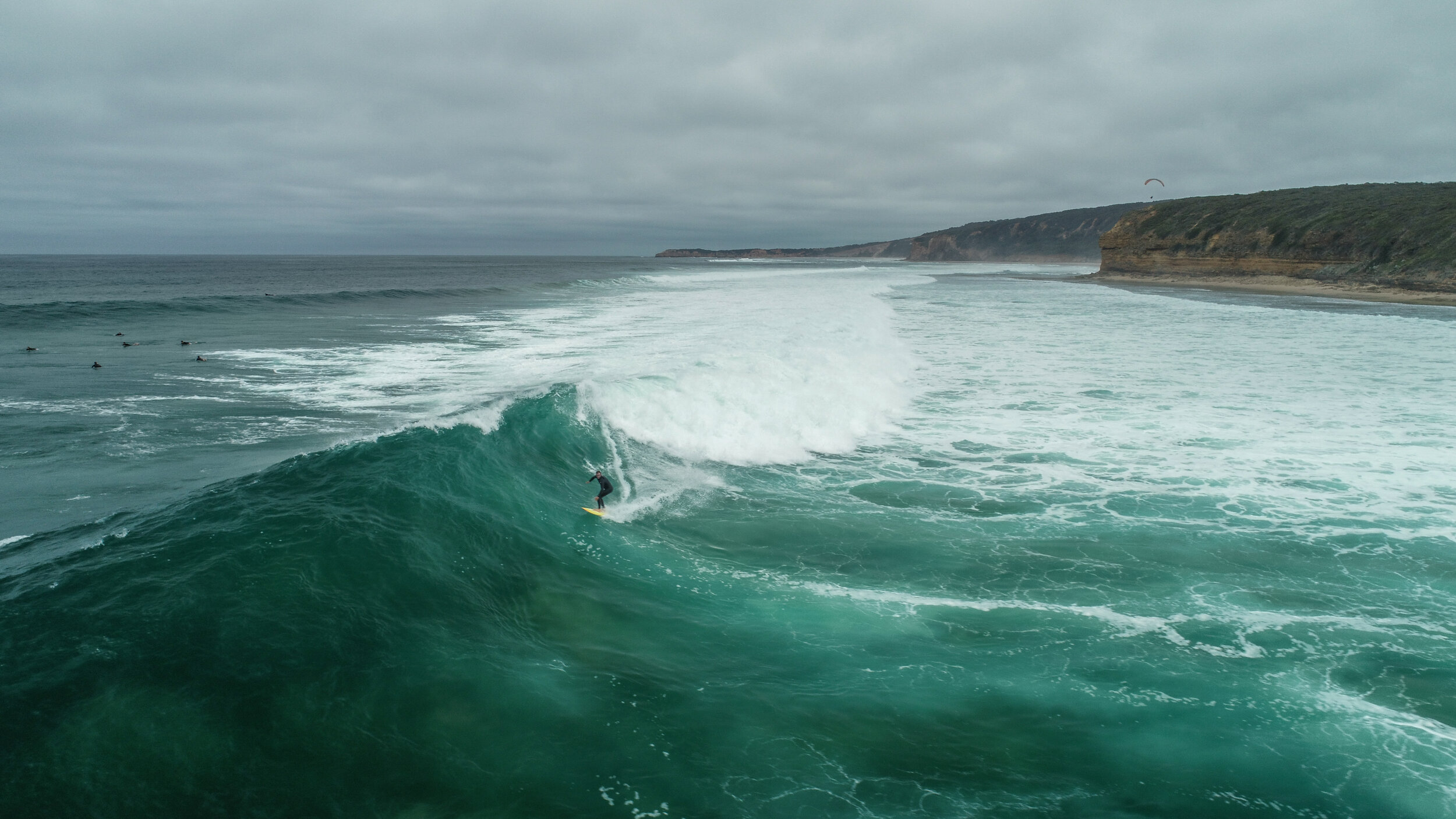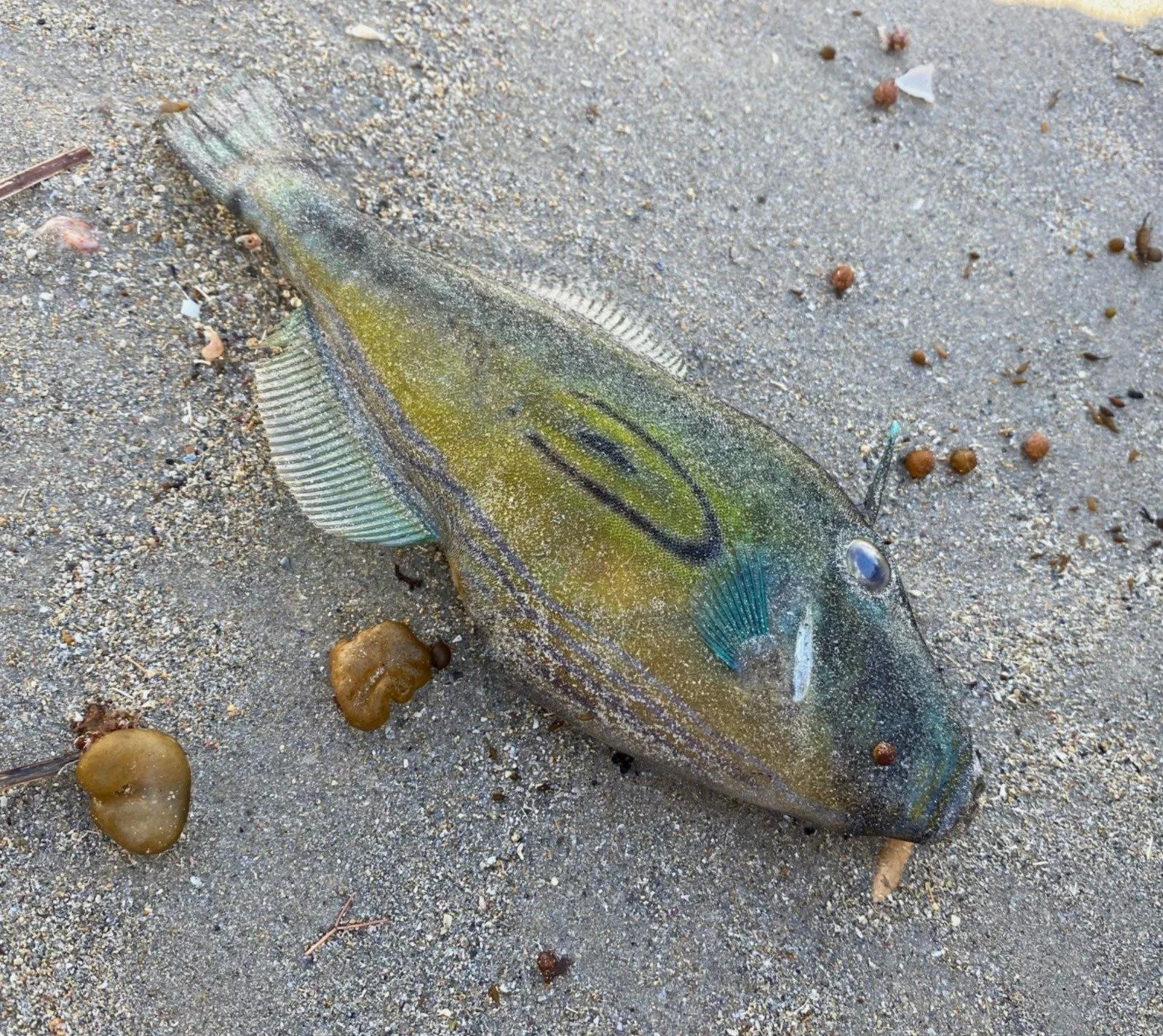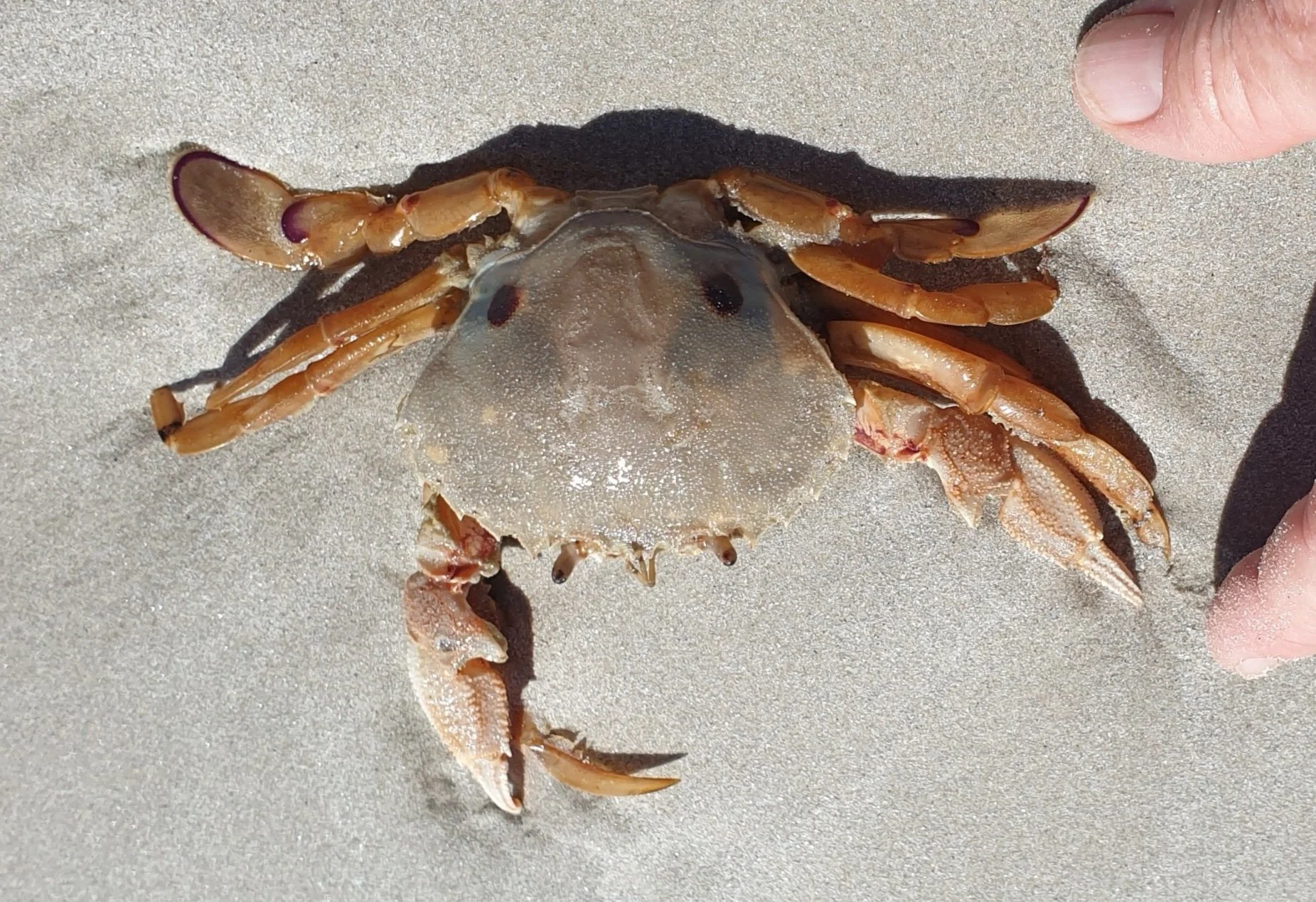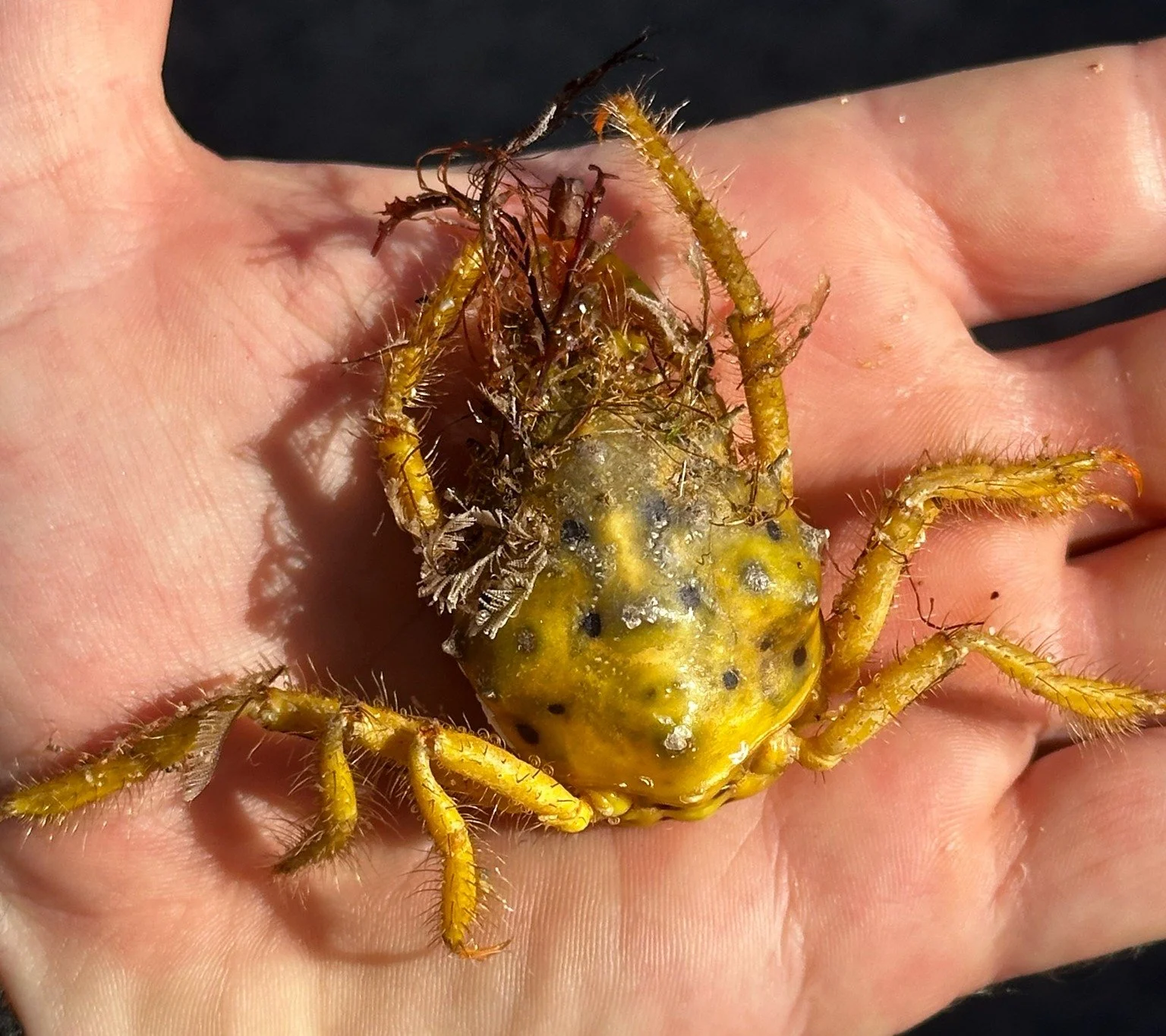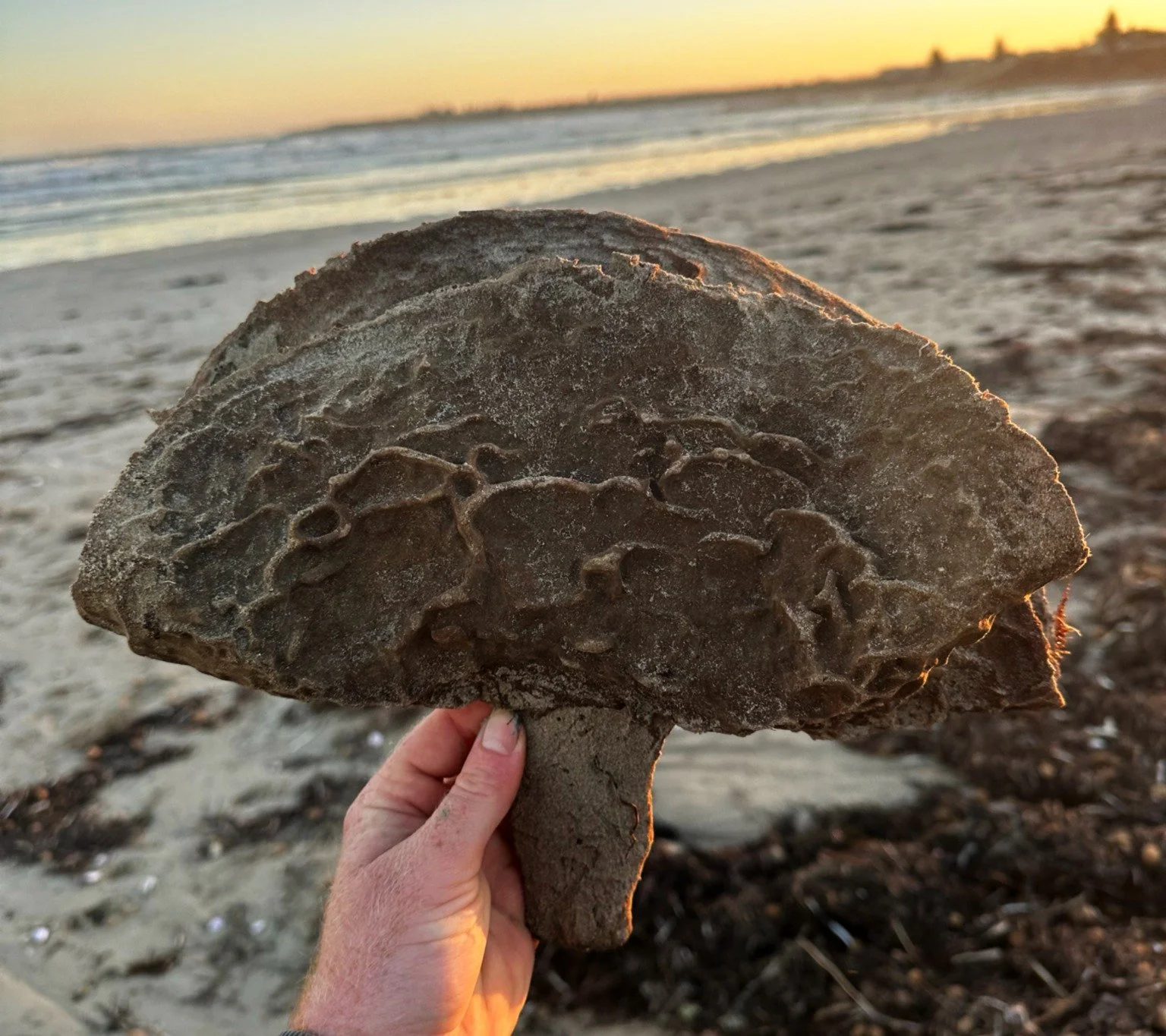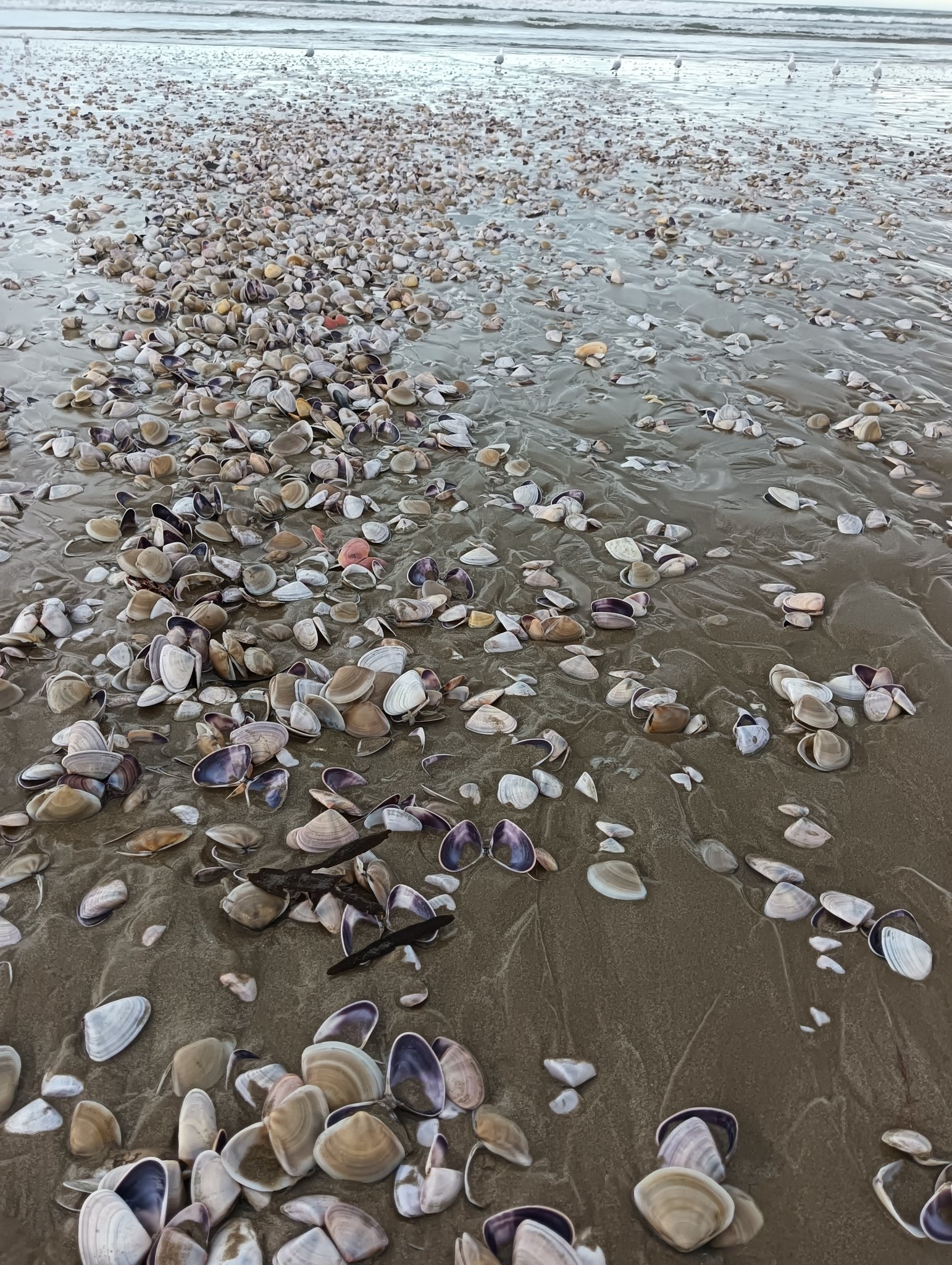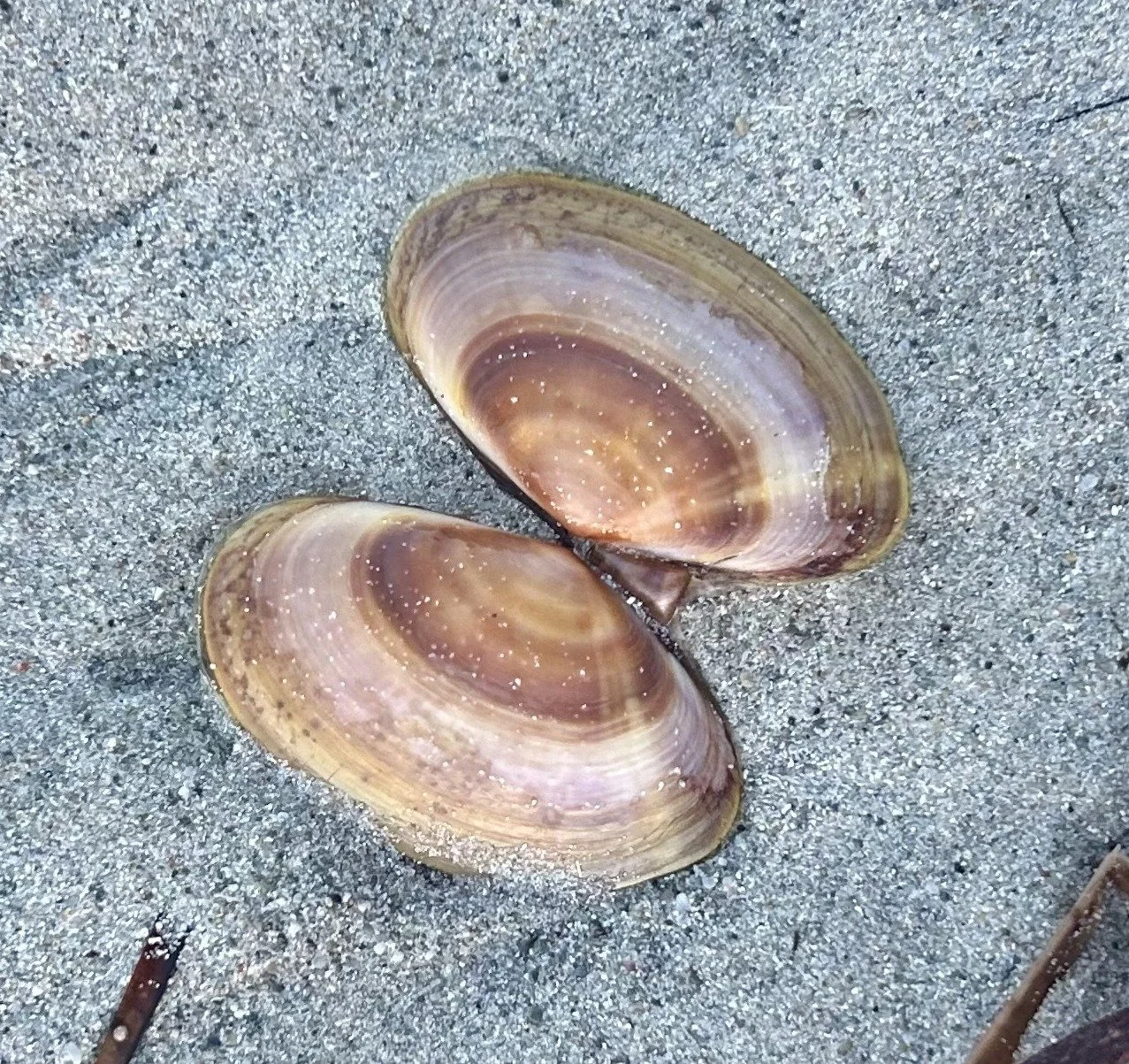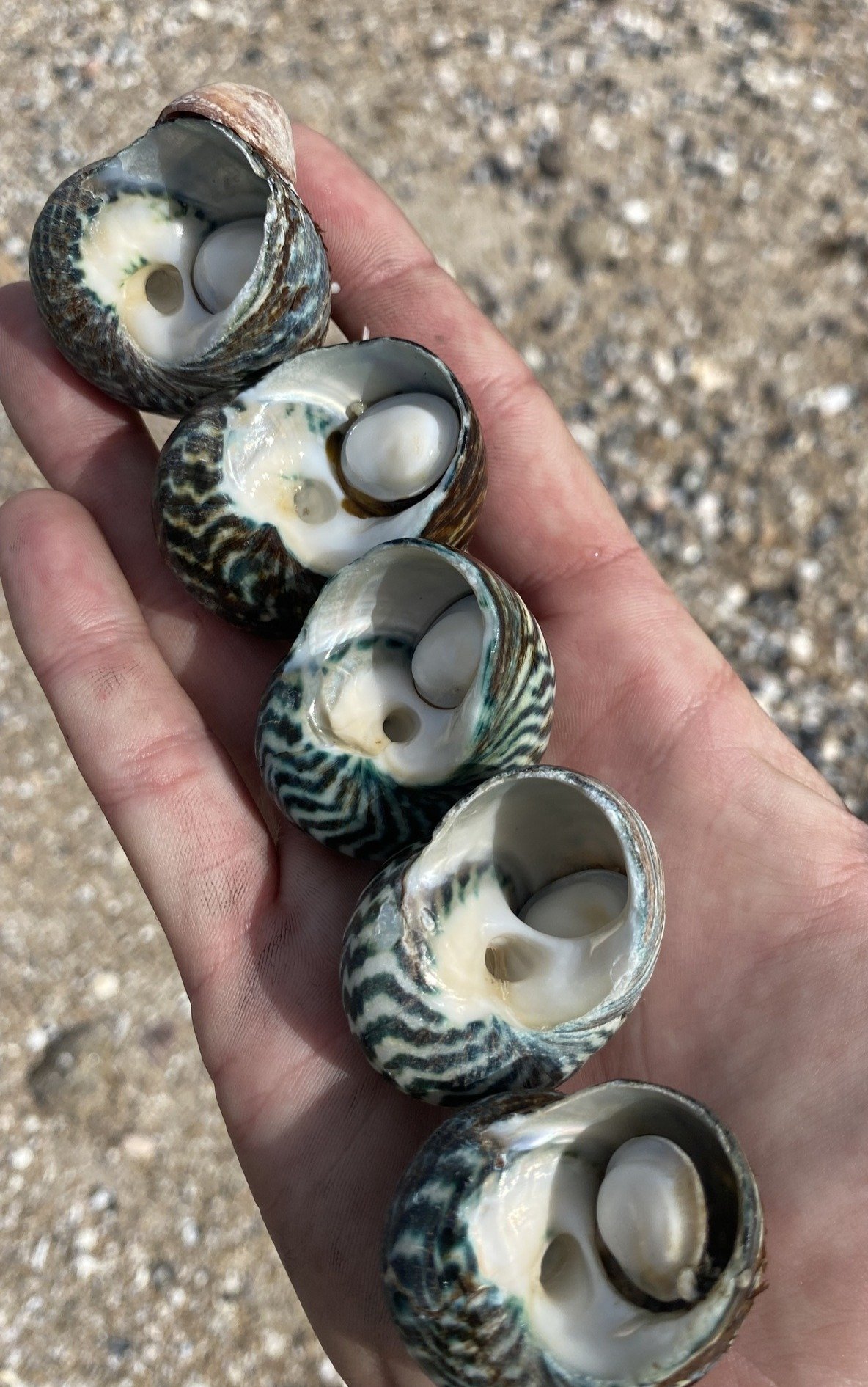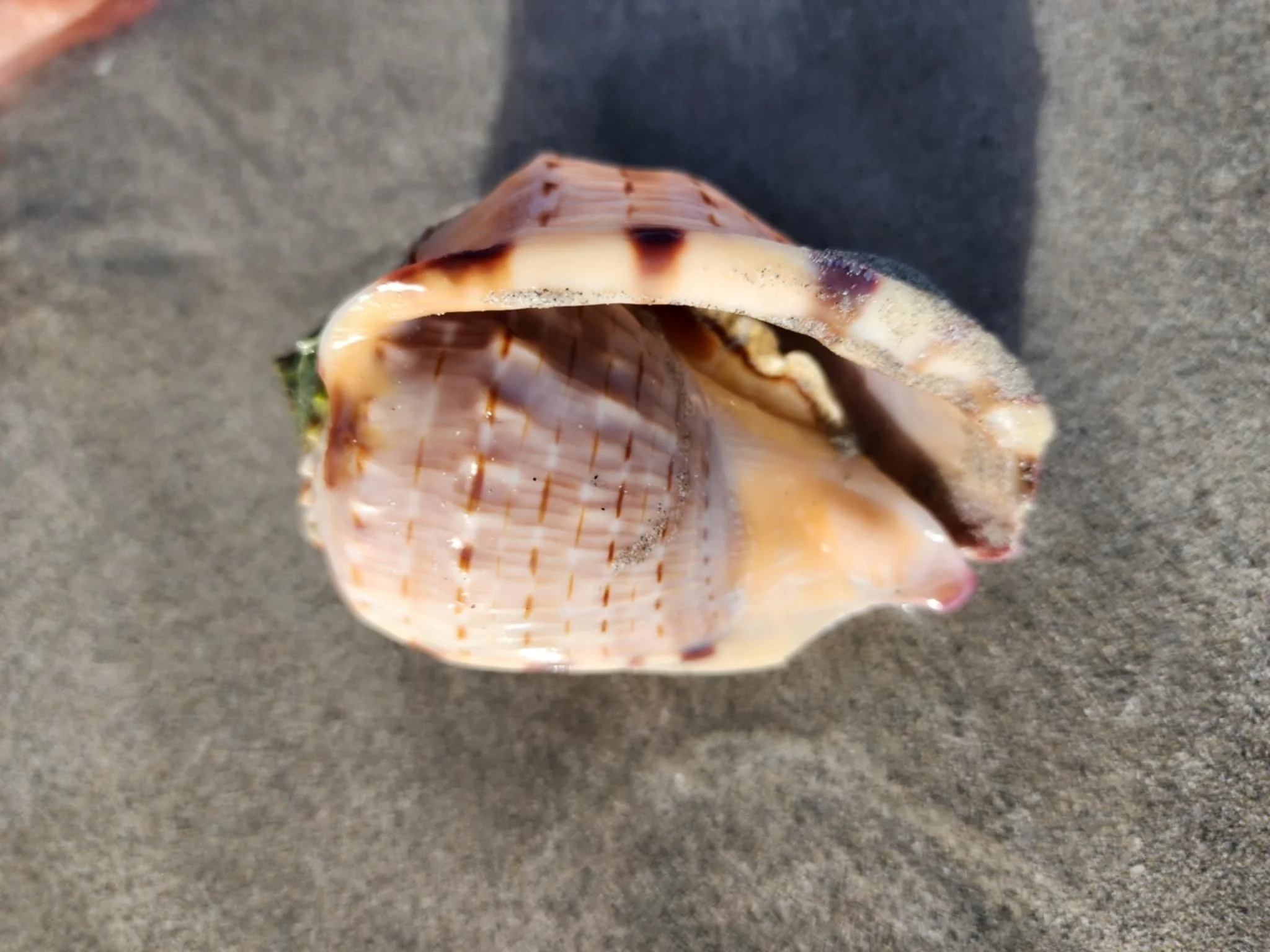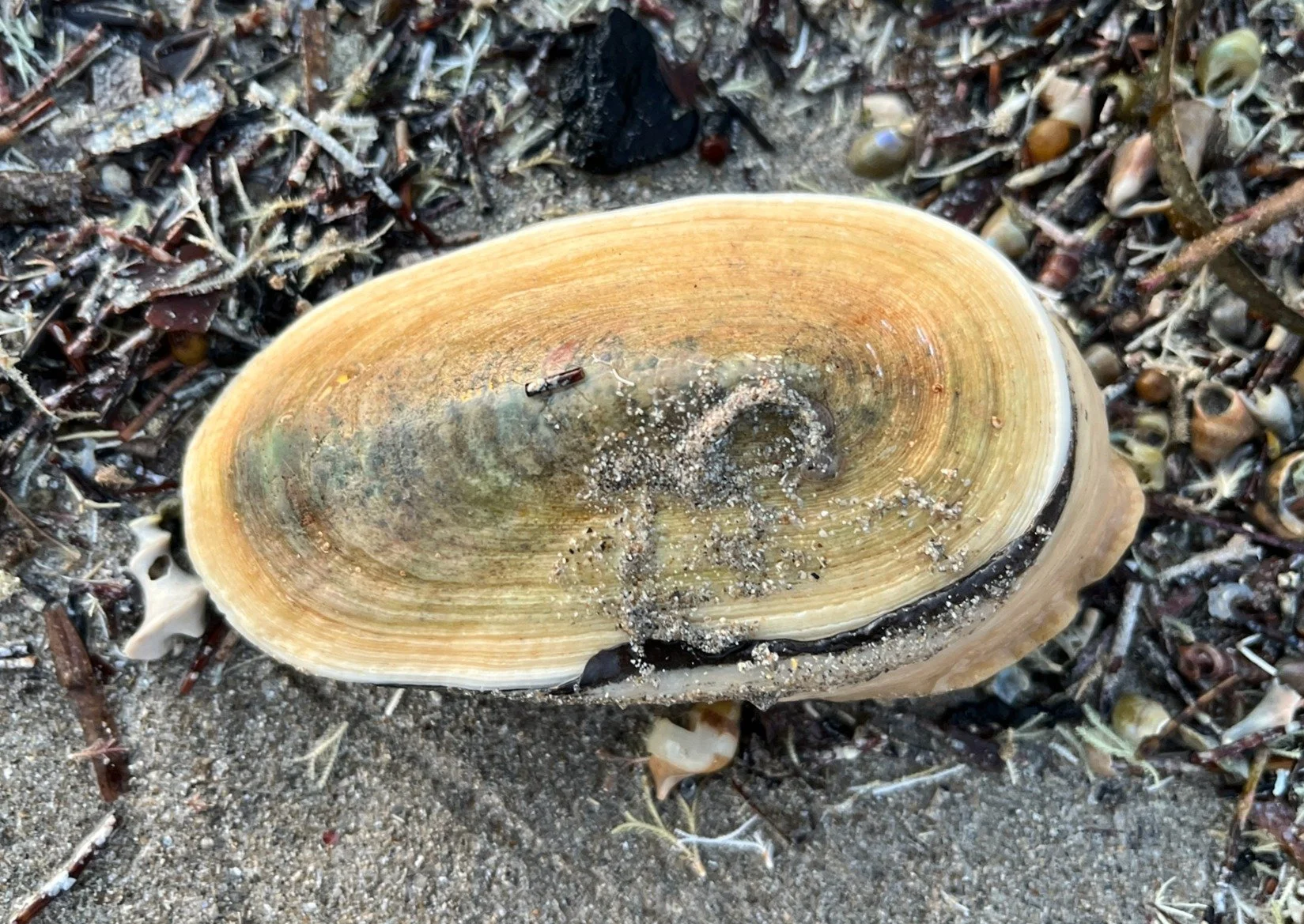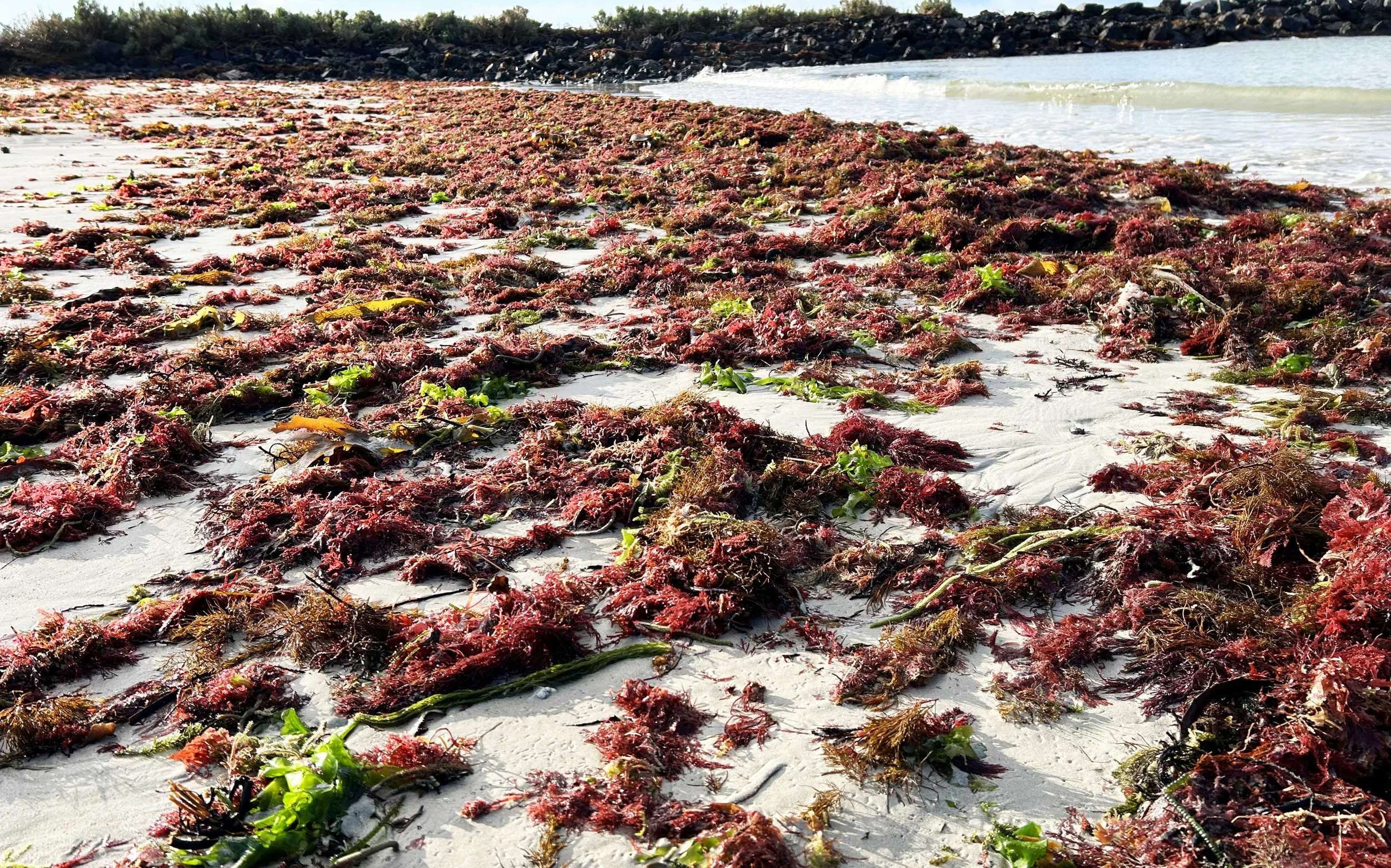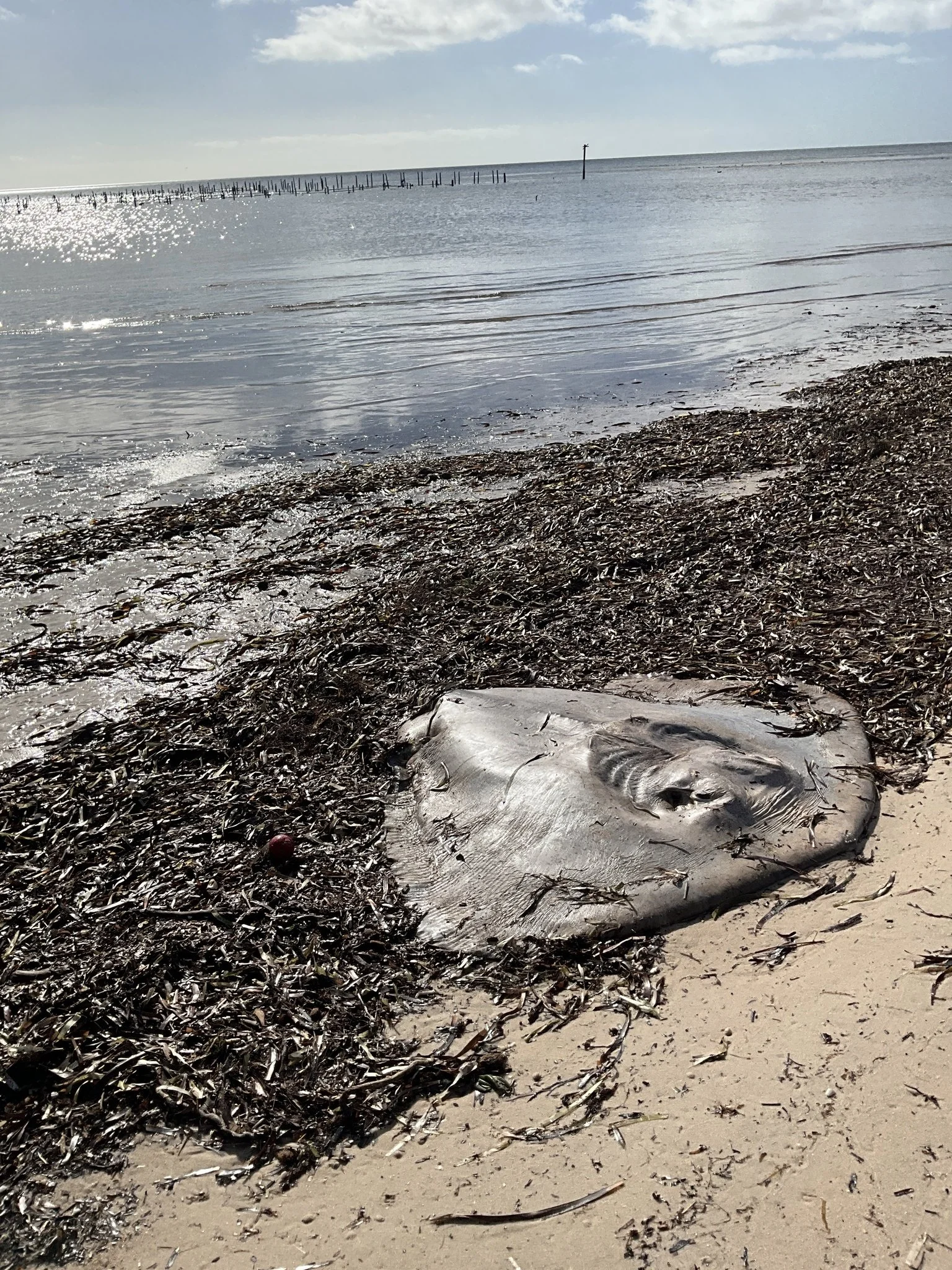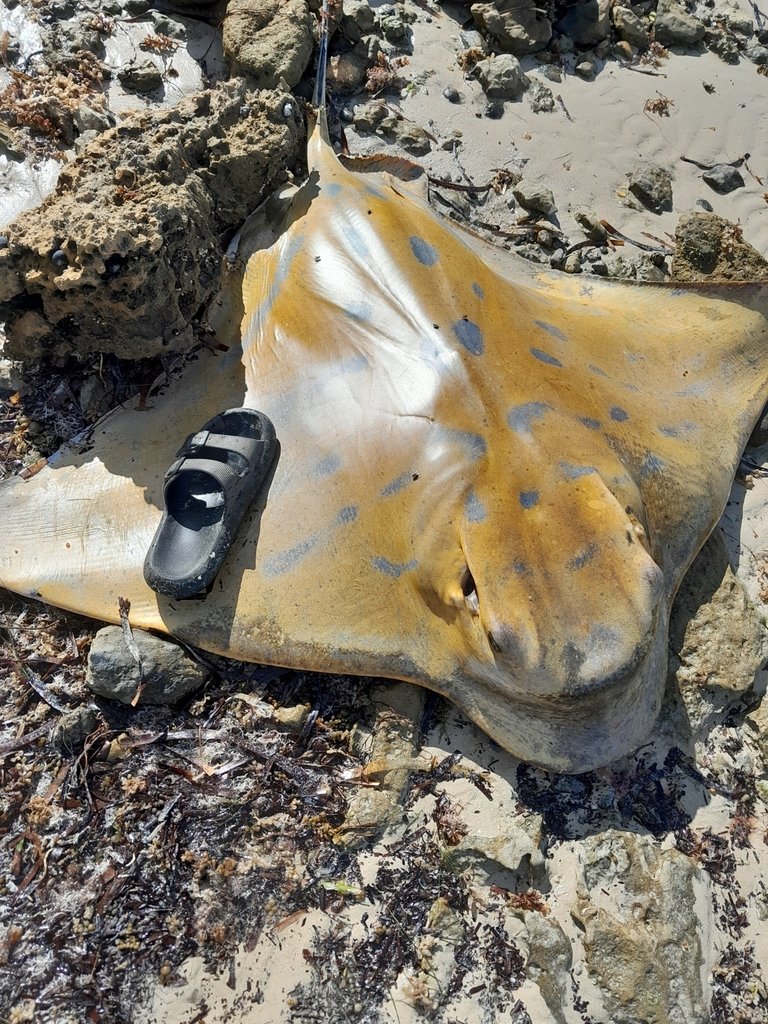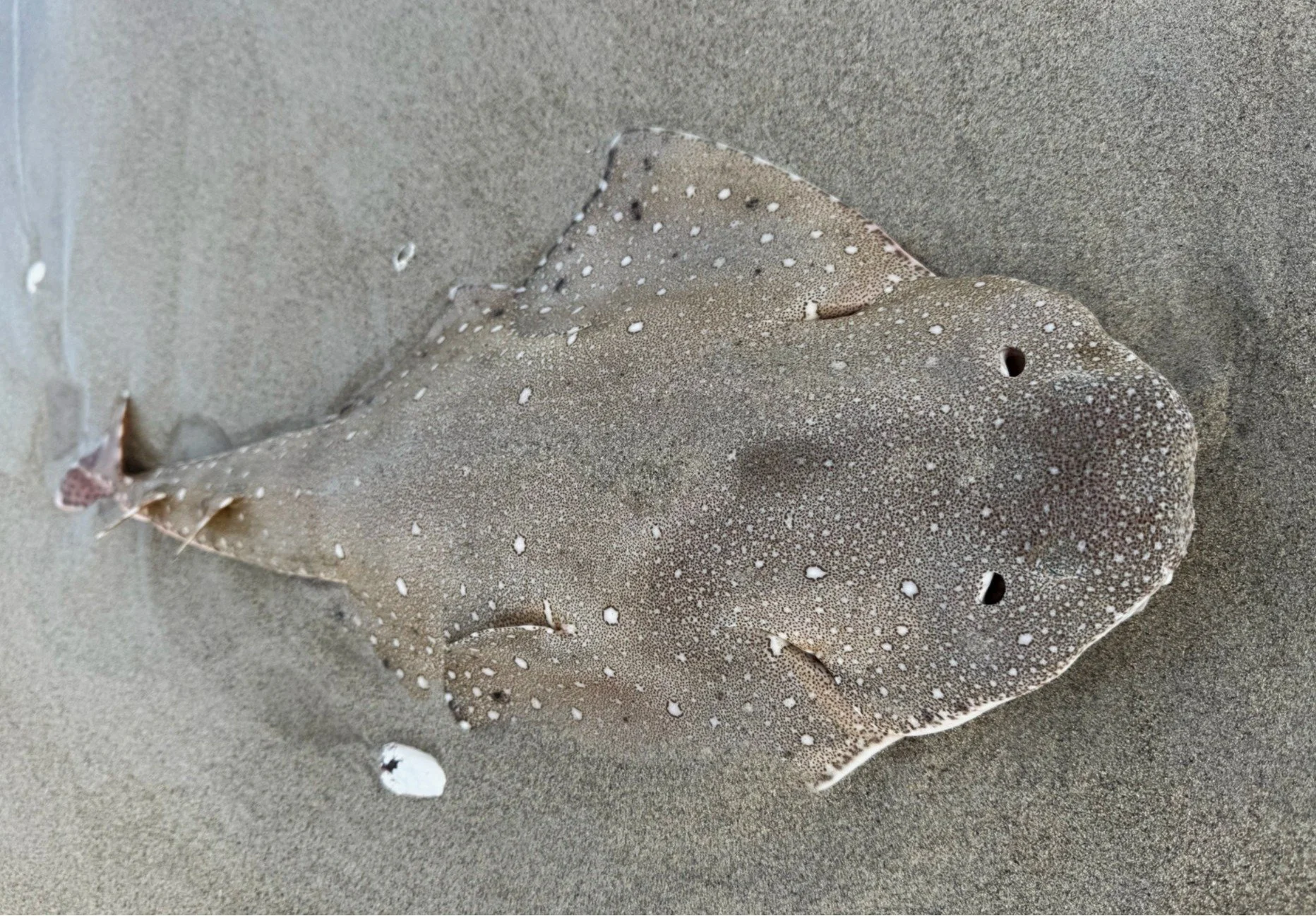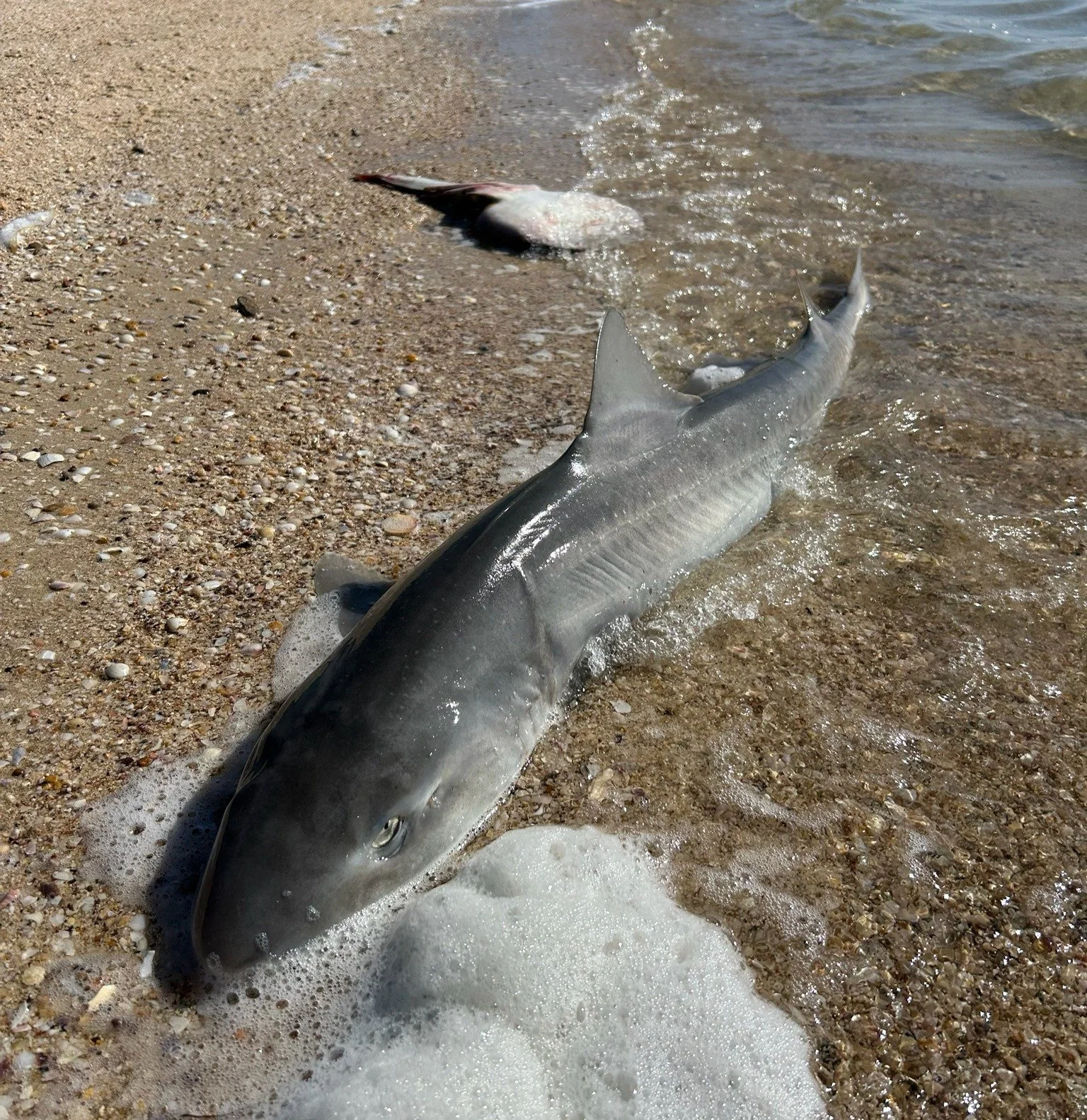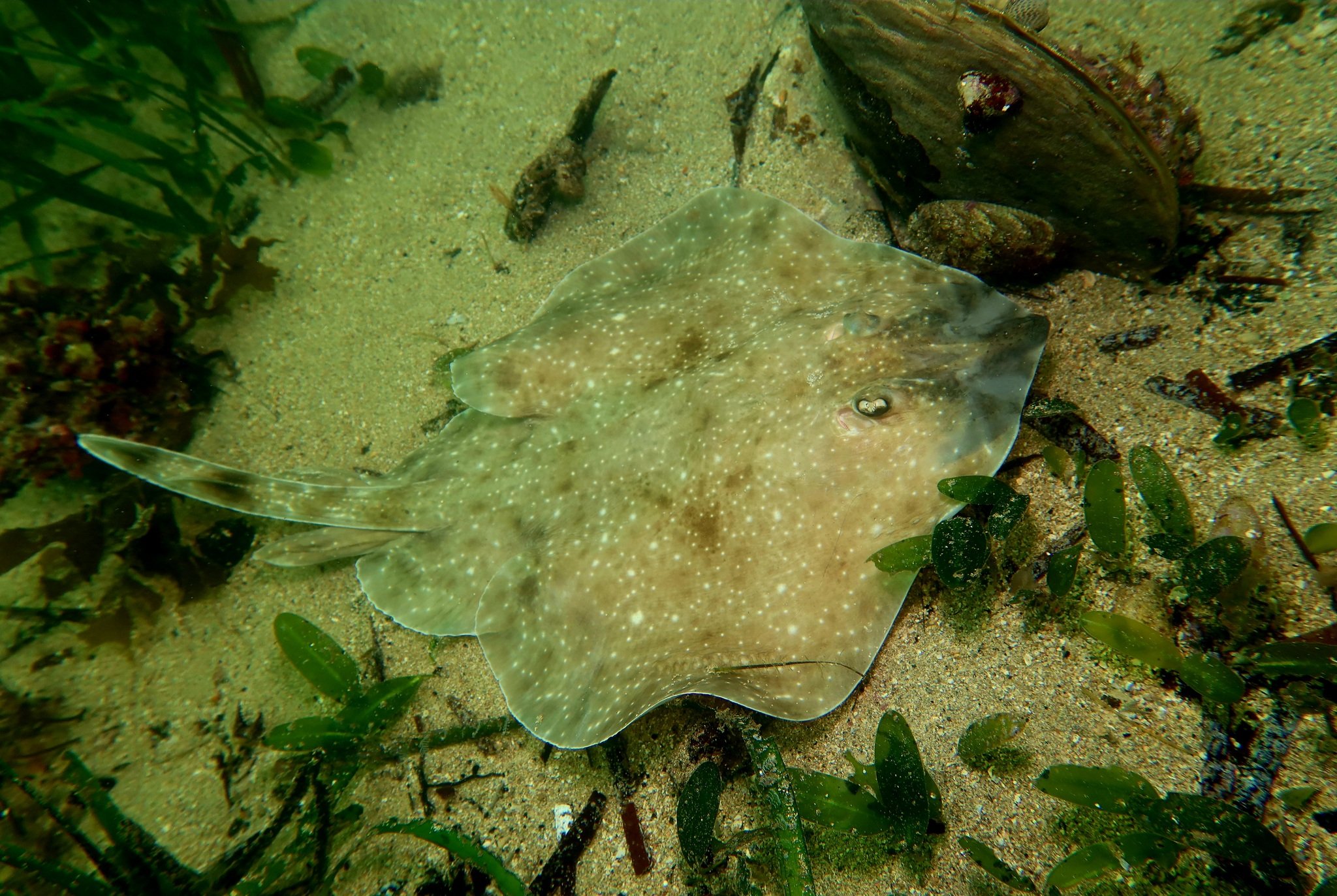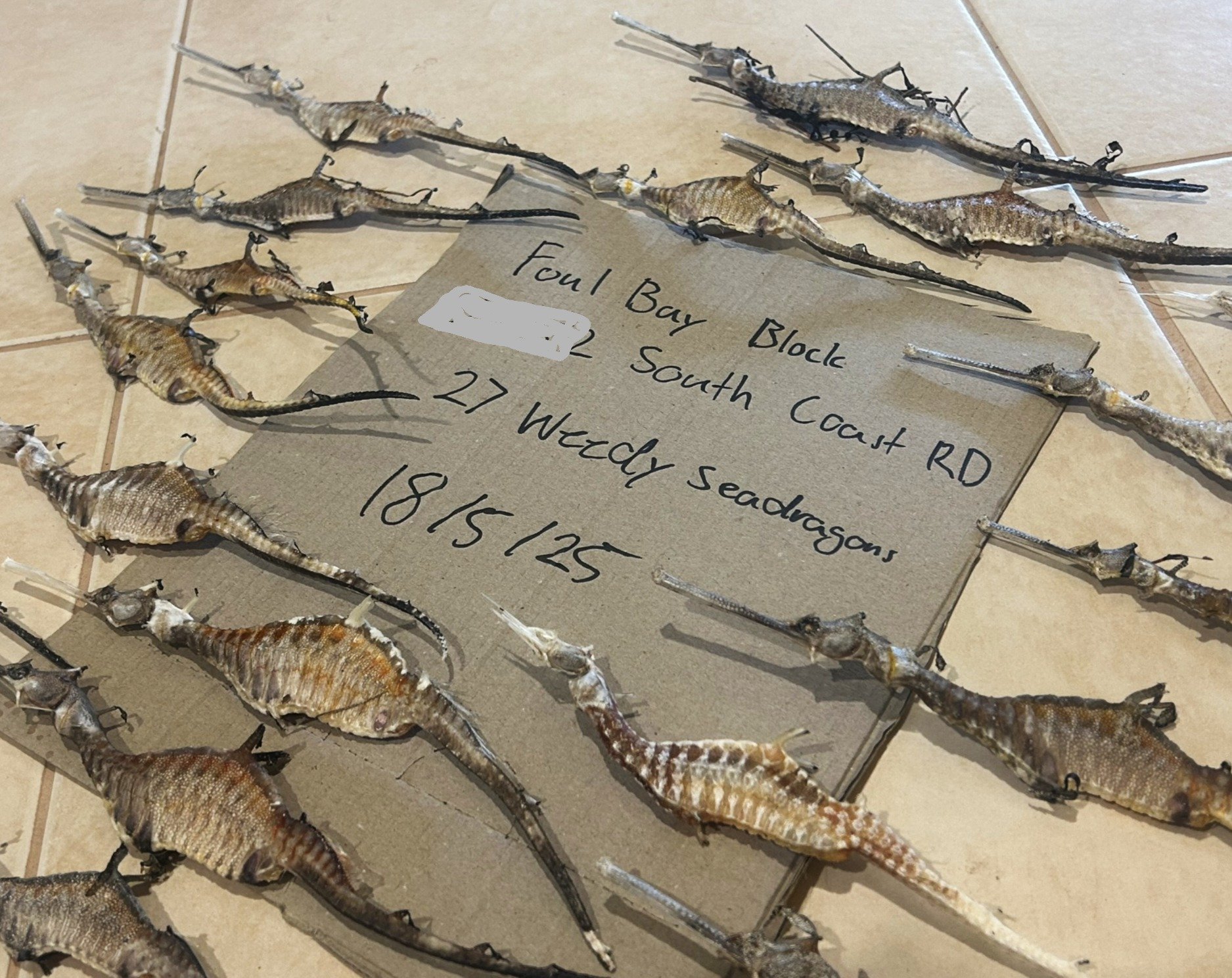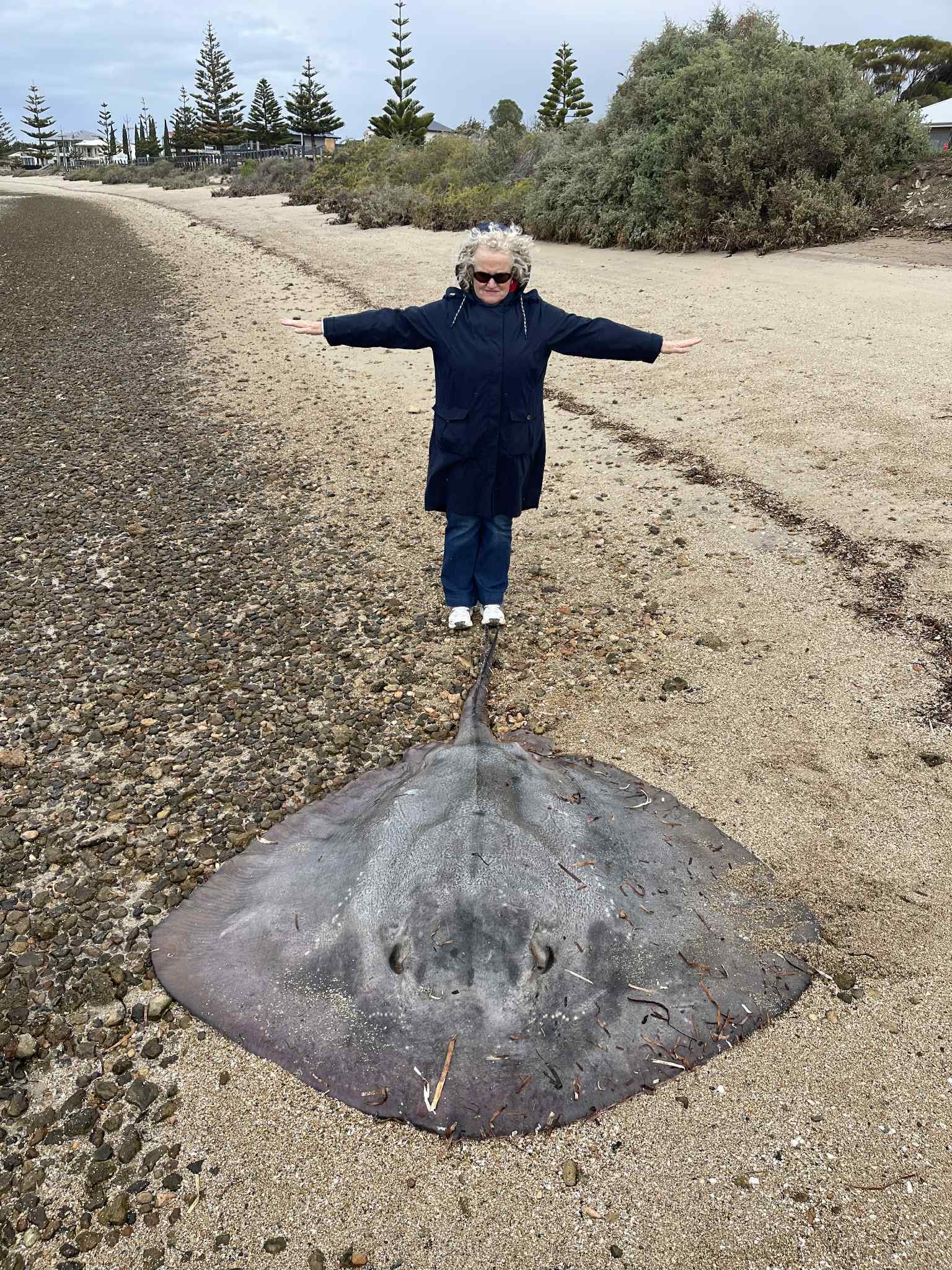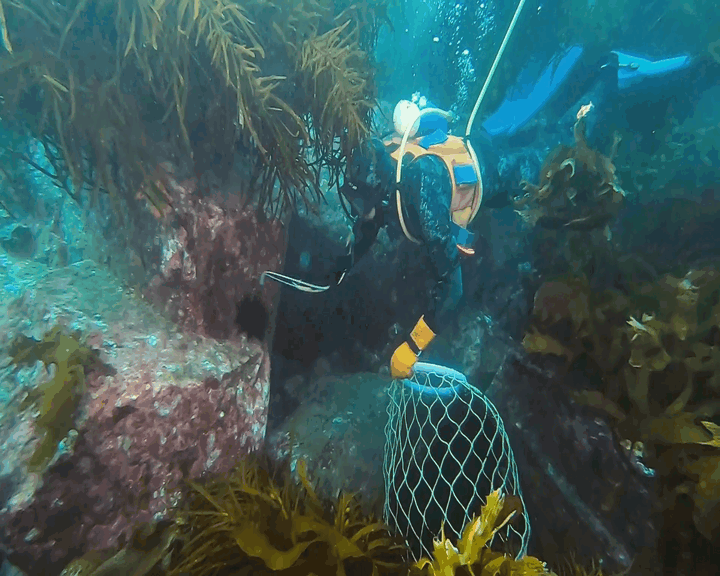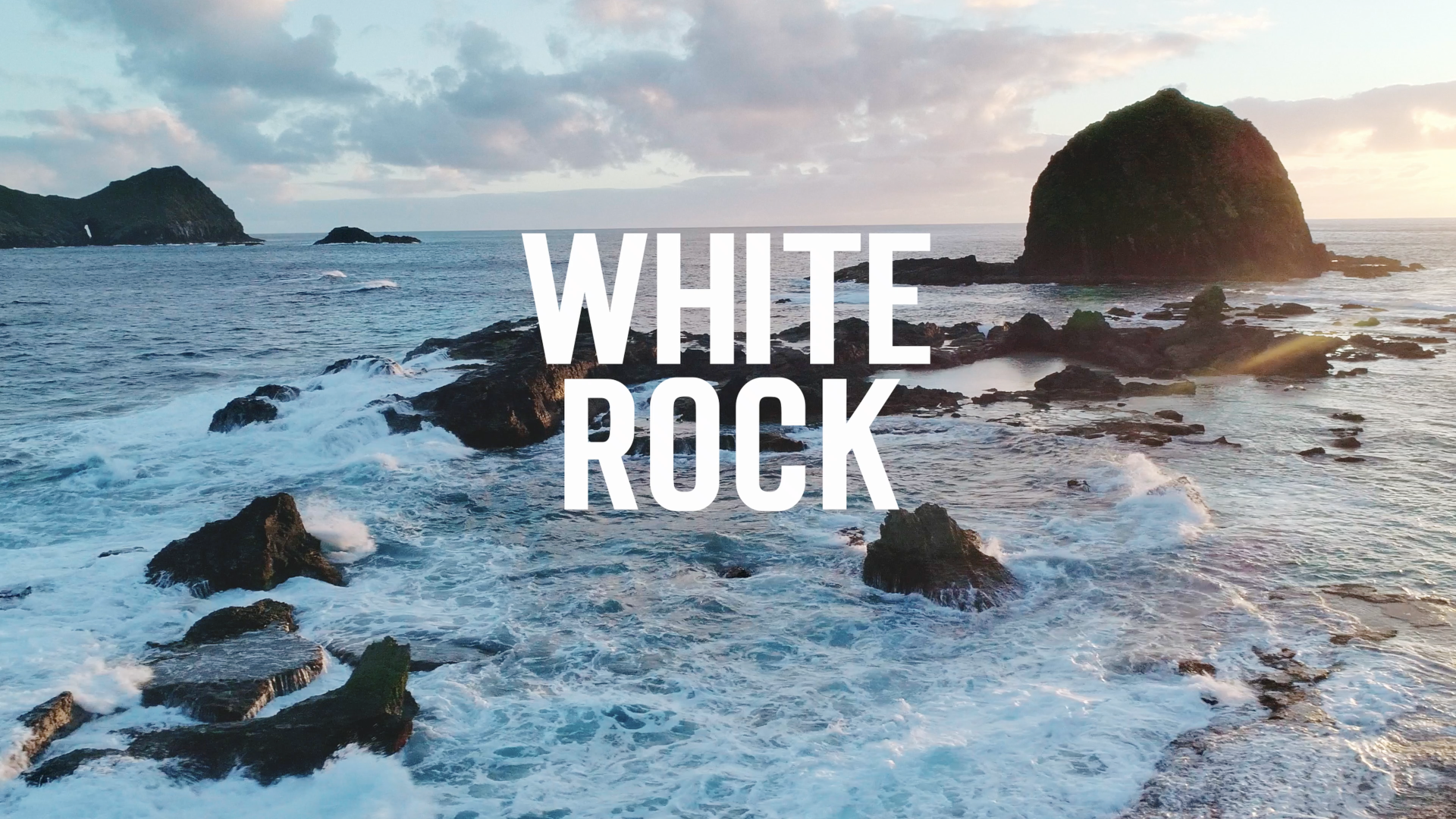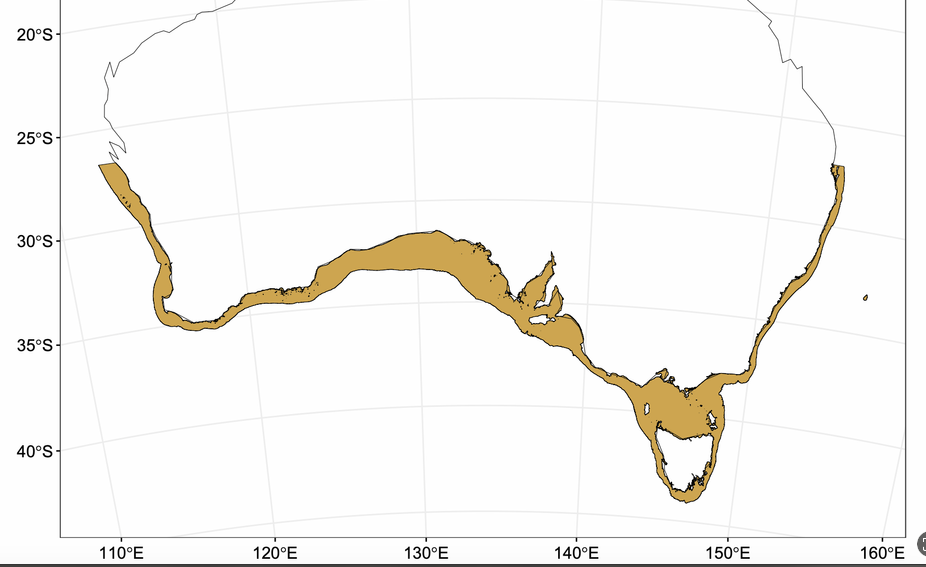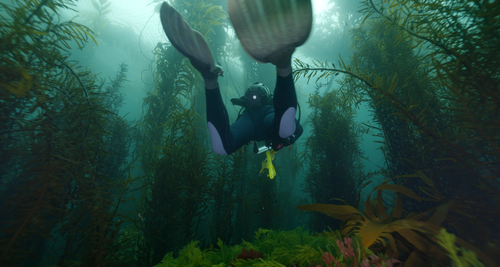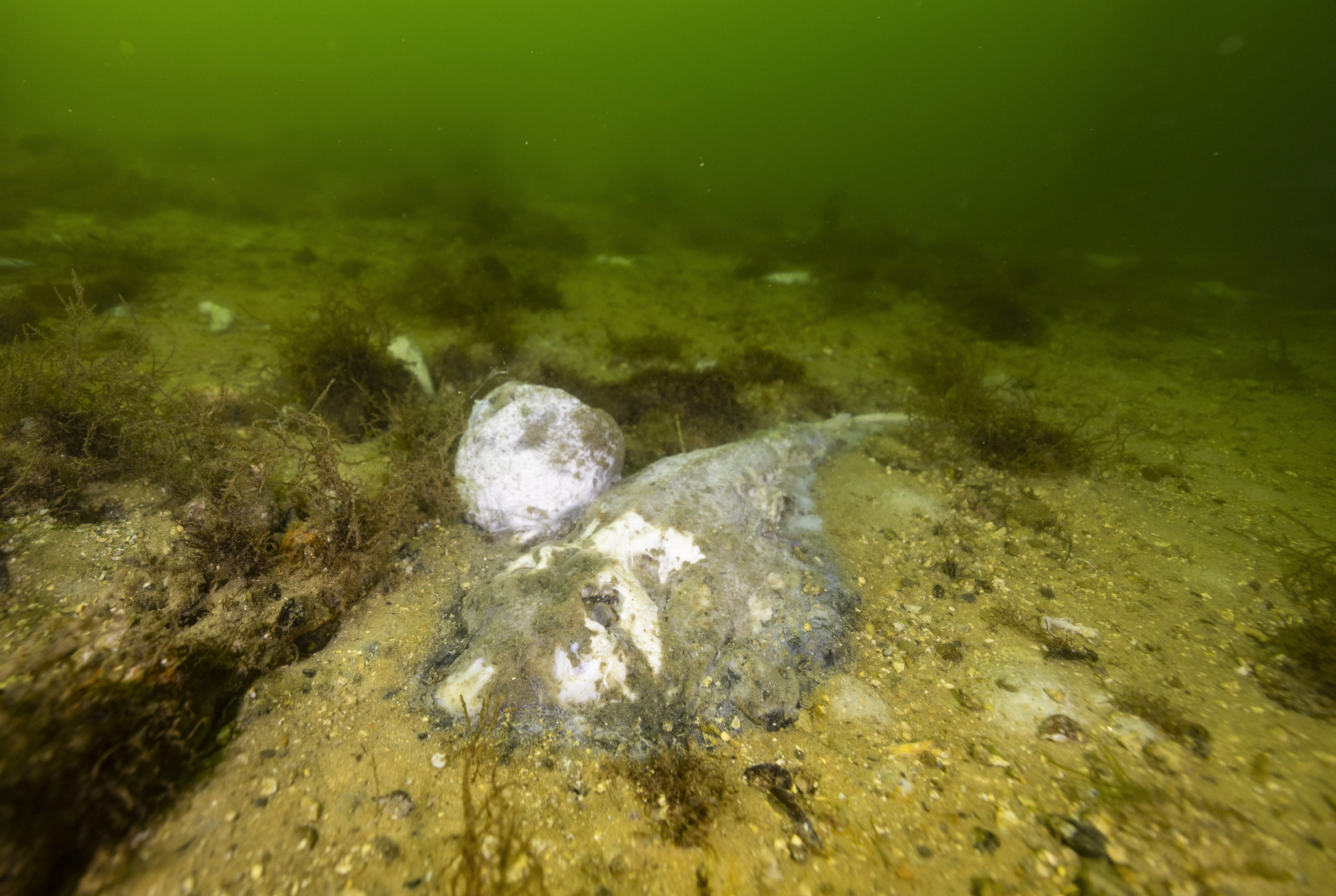
Still Blooming
Tracking the Toll of South Australia's Persistent Harmful Algal Bloom
By Janine Baker for Great Southern Reef FoundationIs the harmful algal bloom (HAB) in South Australia still harming?
Throughout autumn and now into early winter 2025, the harmful algal bloom (HAB) in South Australia’s marine environment has continued to kill marine life at all levels; reduce population numbers of many marine species; damage benthic habitats, and negatively impact coastal towns and marine activities.
A lone golden kelp holdfast clings to life on a reef stripped bare, surrounded by bloom-stained green waters at Edithburgh by Stefan AndrewsAs investigations and discussions with local communities continue across affected regions in South Australia, it is evident that marine mortalities with similar presentations of beached fishes, benthic sharks, rays and numerous invertebrates have been occurring since 2024 in the South East of SA, and from at least summer 2024/25 onwards, in some other South Australian waters further north-west.
A perfect storm: climate extremes and nutrient surges collide
The mix of contributing factors in South Australia’s bloom is complicated, and requires further detailed investigation over space and time.
In other countries, long-lived Karenia blooms of more than one species are attributed to multiple causes, not any single cause. Some of the principal contributing factors in the generation of such Karenia-dominated blooms include:
nutrient upwellings
nutrient-polluted coastal freshwater discharges after floods
unseasonably warm air and water temperatures / heat wave conditions
extended calm oceanic conditions for bloom formation
large quantities of dissolved organic matter, including organic carbon, to fuel harmful dinoflagellates
(Aoki et al. 2019; Su et al. 2024; Miyake & Onitsuka 2025; Zhang et al. 2025; Park et al 2022)
All of these factors have been present in the South Australian marine environment during the past 2 years when marine fish kills have been observed regionally. The heat wave over summer 2024 and autumn 2025, with largely calm conditions and light winds, provided ideal conditions for widespread bloom generation and spread, aided by preceding generative factors. The visible die-off and break down as a nutrient source of enormous quantities - ie tonnes - of seagrass and seaweeds at locations right across South Australia during the summer and autumn heat wave, would have provided powerful fuel for the development of harmful algal blooms. Once harmful dinoflagellate blooms form in the required conditions, they can become self-perpetuating, moving across vast marine areas, and also moving up and down the water column, utilising available nutrients - including dissolved organic matter - for growth. There is no evidence in the literature that increased salinity is a factor in Karenia mikimotoi bloom formation. That species blooms in low salinity and oceanic salinity conditions (Li et al. 2019), and some studies report a negative correlation of bloom growth with increasing salinity.
Reading the Red Zones
Over the past few months, the distribution of new fish kills being recorded in SA matches the distribution of oceanic chlorophyll content in bloom-impacted areas. The deeper water “red zones” represented bloom-affected locations where hundreds of the larger and more visible species have washed up on adjacent coasts.
False colour satellite imagery of chlorophyll concentrations in deeper water areas of South Australia in May and June. Note that the “red zones” in very shallow waters of the gulfs on these dates are not indicative of the main oceanic bloom, as sediments and multiple species of common microalgae in shallow bays, can have the same reflectance values in remote sensing)Both the Kangaroo Island and Yorke Peninsula sides of Investigator Strait continued to be harmed by the bloom throughout May and early June. Over mid and late autumn, the harmful bloom continued to move northwards into western Gulf St Vincent, assisted by clockwise current patterns.
The HAB spread to mid-northern Gulf St Vincent in mid June, evidenced by high ‘red zone’ oceanic chlorophyll levels to 30m deep across that latitude, reports from western GSV fishers of ‘no fish’, continued wash-ups of fresh dead marine animals (including a huge, internally bleeding stingray ) in the Pt Vincent area, and the first signs of unexplained mortalities of some fishes, rays, seabirds and shells, on the northern Metro beaches south of Port Adelaide.
Dead fishes, sharks, rays and many groups of invertebrates have been seen over recent months in Wool Bay, Stansbury, Port Vincent and surrounding coastal areas. The death toll has continued into June off southern Yorke Peninsula’s bays and headlands, with reefs, seagrass beds and sandy habitats impacted.
The reported mass wash-ups of dead benthic sharks and rays, seadragons and cephalopods in April and early May, changed composition over time, with more fishes from reefs and seagrass beds, lobsters, and shells being photographed and reported over late May and June.
Deaths of marine animals from the extended HAB in South Australia continue to be frequent and alarming. In the absence of subtidal surveys in most areas, the bulk of the available information so far comes from the beach wash-ups. These records are dominated by mainly mobile but site-associated sea floor species; fishes from reefs, seaweeds and seagrasses; and sand-dwelling invertebrates.
What the Beaches Are Telling Us
While marine deaths along the Encounter surf coast have eased, significant mortality events continued across South Australia in April and May, including dead fiddler rays and Port Jackson sharks in southern Gulf St Vincent, and mass wash-ups of cuttlefish and cuttlebones on western Spencer Gulf beaches near Tumby Bay, Port Neill and Bolingbroke. Storms and extreme tides in late May and early June brought further dead animals, seaweed, seagrass and thick sea foam ashore, with water samples from the northern Coorong revealing toxic Karenia blooms alongside dead estuarine fish, crabs and thousands of worms.
The tally of mortalities reported to the SA Marine Mortality Events iNaturalist Project now amounts to almost 5,000 observations, over 350 species, plus hundreds more animals of many species that cannot be identified to species level from images. Fishers estimate that only a fraction of the marine life that has died offshore and is decomposing on the sea floor, is being recorded in the wash-ups.
What has been learned so far about harmful species in the bloom mix?
Laboratories have now identified in South Australian marine water samples a larger number of harmful dinoflagellate species than reported in April. Microscopic and molecular work continues, to better determine the composition of the bloom species mix over space and time.
Karenia mikimotoi and K. papilionacea have been reported so far as significant HAB species in the mix, along with related plankton in the Karlodinium genus. Over the past few months, other potentially harmful microalgae have been recorded in bays, estuaries, and other waterways in SA. They include species in Dinophysis, Gymnodinium, Pseudochattonella, and also the sea sparkle Noctiluca scintillans, amongst others. Karenia mikimotoi is considered one of the most harmful algal species in Japan and China (Sakamoto et al. 2021), producing what are described as “extremely lethal” blooms that have impacted marine life across Asia, Europe, Oceania, Africa and North America (Li et al. 2019; Miyake & Onitsuka 2025). Some of the impacts of Karenia mikimotoi, one of the main species reported in the bloom mix, are further explored in the previous article on the 2025 HAB bloom in South Australia and in a recent science forum.
Other Karenia and Karlodinium species have been recorded previously in South Australian waters, such as K. longicanalis (a synonym of the Tasmania species K. umbella, according to Wang et al. 2018) and Karlodinium australe. Karenia longicanalis is known to form blooms in waters off Hong Kong and China (Yang 2001; Wang et al. 2018)
The multi-species nature of the extended algal bloom in South Australia mirrors what is being seen in other parts of the world, with both cool-water tolerant (e.g. K. mikimotoi) and warmer-water species (e.g. K. papilionacea) being found in the same bloom. Globally, Karenia HABs are increasingly being attributed to multiple species, including new and as yet undiscribed species (Zhang et al. 2025).
Main ways in which some of the HABs in the South Australian “bloom mix” can kill are summarised in the Appendix. The content is based on review of the Karenia and Karlodinium literature by retired neuroscientist and professor of anatomy Emeritus Professor Ian Gibbins and marine ecologist Janine Baker.
What do we know so far about the impacts?
The significance of the environmental damage that this extended HAB has caused is not yet fully realised. Sporadic reports from fishers and divers, coupled with small area ROV surveys by independent operators, have revealed that benthic habitats across the southern and central SA coast and Kangaroo Island have been damaged by the HAB.
In many of those areas, populations of both mobile and attached species have been seriously impacted. In some locations, this extends to at least 30m deep. However, much of the evidence remains hidden below the water line, decaying on the sea floor, and the lack of surveys during the past few months remains an impediment to understanding the full extent of the “first wave” (active bloom period) impacts.
Blue weed whiting by sharliebarlie and rough leatherjacket by Lochie CameronRecreational and commercial fishers across bloom-affected regions of SA have reported the same information: “the fish are not biting”; “we didn’t catch anything”; “we only found one fish species”; “no fish in our usual spots”. In two bloom-affected regions - southern Investigator Strait and western Gulf St Vincent - fishers report that early in the period, some fish species were apparently driven ashore by the conditions, and large numbers of whiting were easily caught in shallower waters than usual, including areas where whiting are not normally abundant.
Bloom Death Evidence: Same Sequence, Different Areas
Notably, the “sequence of deaths” in the beach wash-ups over time has been similar in various parts of SA where the harmful dinoflagellate bloom has passed though, and stayed for a lethally long period. Some of the first species to be noticed dead in the water and washed up on the beaches in bloom-impacted locations were cephalopods, particularly octopus and cuttlefishes. In March, mass wash-ups of octopus were reported on the Encounter Bay surf coast and also along the southern Yorke Peninsula coast, but visual evidence is not available for the latter area. At Edithburgh in SW Gulf St Vincent, when the toxic bloom hit in early April, divers observed several species of octopus as the first wave of mortalities, well before the site became a “dead zone”. Thousands of dead cuttlefishes and cuttlebones of more than one species have washed up in bloom-impacted locations around SA, from southern Eyre Peninsula through to the upper South East. The “mass cuttlebone flotsam ” later expanded to metro areas, with hundreds and thousands being found along individual beaches over the past month or more.
Dead octopus on the Encounter Bay coast, March 2025 by Mickey Mason
Piecing Together the Evidence
Throughout the bloom-impacted locations, the exact cause of death cannot be confirmed without necropsy and toxicology, which has not been undertaken for the cephalopods or fishes. There has been much speculation about the exact causes of mass death of marine fauna across South Australia in 2025, but research in other countries where Karenia-dominated and/or Karlodinium-dominated blooms have occurred indicate that some of the leading causes of death include gill tissue breakdown due to direct contact with whole algal cells and their toxins; and also suffocation from “algae-stuffed gills” and the consequent immune reaction (such as mucilage production) following direct contact with the harmful dinoflagellates. Cephalopods are harmed by even short-term exposure to Karenia cells (e.g. Natsuike et al. 2024), and over their relatively short life cycle, cephalopods can also store toxins from harmful algal bloom species (e.g. Lopes et al. 2013).
Early signals
Early in the bloom period, small fishes in the related families Tetraodontidae (pufferfishes, toadfishes) and Diodontidae (globefishes) also washed up in large numbers across southern Yorke Peninsula, Encounter Bay, and Kangaroo Island. These fishes can inflate their highly elastic stomachs, and can thus be rafted ashore after death, instead of sinking to the sea floor. On southern Yorke Peninsula, local fishers have been watching dead pufferfish wash up since late February – early March (R. Ljubicic, pers. comm., June 2025). Some of the wash-up statistics for diodontids and tetraodontid fishes are shown in a table below.
Seadragons - which have small gill pores that can easily be clogged with the harmful algae, and limited ability to swim away from bloom-heavy waters - were also some of the early wash -ups. These light fishes with a hard bony case have washed up in the hundreds in bloom-impacted regions, and are discussed in more detail in other sections of this article.
Australian Angel shark by Melissa AlleryDisplaced and Disrupted: Where Are the Fish Going?
Whilst fish are missing from some areas, they are turning up completely unexpectedly in other places where they normally do not occur, sometimes in abundance. Both commercial and recreational fishers have reported the same thing during interviews over the past few months, from the South East through to SW Yorke Peninsula and Kangaroo Island. Spots where fish have been observed seasonally for years without fail, are empty. In other locations, recreational fishers have been ‘bagging out’ on large King George whiting in the shallows, some in the 40 to 50 cm range. This is not usual. The nearshore catches likely include older breeders that are usually further offshore, and have been driven closer by the HAB. Other fishes, sharks, rays and even squids are moving out of their normal habitats too. Amongst a myriad of other very serious ramifications, the ongoing HAB impacts mean that current marine fish species population dynamics models and stock assessments will need to be revised.
Expanding Impacts
Following the “sentinel species” such as cephalopods, pufferfishes and seadragons that signalled the mass deaths that were to come, benthic sharks, rays, cockles and many other species started washing up in the central SA coast and Kangaroo Island en masse.
During the past few months of the active bloom, much of the information about mortalities has come from a very limited area – above the tide line, and in the shallows where dying fishes, sharks, rays and a multitude of invertebrates are being observed. Some of the larger animals display unusual behaviours that are characteristic of Karenia bloom exposure, possibly including systemic impacts from neurotoxin exposure
Wash-Ups Reveal a Fraction of the Full Impact
The coastal wash-ups, however numerous and significant, represent only a fraction of the full impact over space and time. From sea floor shells and sea cucumbers through to seals and sharks, the death toll continues unabated. To date, some of the most numerous wash-ups during the 2025 HAB in South Australia include those in the following tables.
Recently deceased juvenile greenlip abalone underwater at Edithburgh by Stefan AndrewsBony Fishes – Victims of the Bloom
Between February and late June 2025, more than 2,500 records of dead bony fishes in bloom- affected regions were reported by community to the SA Marine Mortalities project on iNaturalist, comprising around 136 species.
The table below details the fish species or genera for which more than 15 records have been submitted. For some species, there are more than 100 records so far. Some of the single records represent numerous individuals, such as dozens of seadragons and flatheads washed up. The majority of bony fish species washing up around SA comprise four main groups:
-
Seagrass-dwelling fishes, such as tubemouth, some of the leatherjackets, weedy seadragons, rainbow cale, brushtail pipefish and a few of the weed whiting species.
-
Slow, moving, site-associated reef fishes. This includes smaller, ledge- and crevice-associated fishes such as bullseyes and mouth-brooding cardinalfishes, globefish, and larger reef fishes such as long-snouted boarfish, Victorian scalyfin, magpie perch and western talma.
-
Sea floor / sediment surface fishes from estuaries, bays and other inshore waters, such as estuary cobbler, various flathead species, beaked salmon, and worm eels (Scolecenchelys). Worm eels feed on small invertebrates near and in sediment, and in turn become food for larger fishes.
-
Mixed habitat fishes that are found in both seagrass and reef areas, such leafy seadragons, cowfishes, dusky morwong and some leatherjacket species.
Nowhere to Flee
Some of the iconic reef species of the Great Southern Reef have also been washing up. Examples include the long-lived (to 60 years) strongly site-associated species Southern Blue Devil Paraplesiops meleagris, and the well-camouflaged, kelp-dwelling Red Velvetfish Gnathanacanthus goetzeei.
The rare and declining red velvetfish by R. Nolan and L. CameronHabitat-associated fishes cannot move away from the “blanket” of toxic dinoflagellates when cell densities in the bloom are high, and such fishes have dominated the wash-up reports so far. Some of the numerous ways in which Karenia and related dinoflagellates can kill bony fishes are outlined in the Appendix of this report. Some of the larger, heavier reef fishes such as blue groper and silver drummer have washed up only incidentally (e.g. ~ 1 blue groper and 2 drummer).
Southern Blue Devils can live to 60 years of age. Image by Caroline Horn.It is possible that in some areas, heavier fish species that may be impacted by the HAB are dying in situ and decomposing, and not being recorded. Fishers report that this may be the case with some of the offshore reef fishes that are now missing from the usual locations, from the shallow subtidal to at least 30m depth. Some of the deeper water offshore fishes have apparently been swimming closer to ashore too, and washing up dead in small numbers. Examples include John Dory and Barber Perch Caesioperca rasor.
Barber Perch, one of the deeper water fish reported closer to shore. Image by DragonberryShifting Fish Patterns and Long-Term Ecological Risks
-
Although only small numbers of commercially and recreationally significant fishes such as whiting and garfish have been washing up compared with those in the table above, recreational fishers on both Kangaroo Island and Yorke Peninsula are reporting absence of common target food fish species in some areas, and presence of unusually large numbers in much shallower waters than is usual. Fish have been “driving themselves ashore” in some areas.
-
Sea floor fishes in sandy, shelly and muddy and sparse seagrass habitats are susceptible to harm from bloom species in numerous ways. Apart from direct gill damage and suffocation during the active bloom period, large quantities of dying toxic dinoflagellate cells sinking to the sea floor promote build-up of bacteria and viruses, and the resultant benthic contents and deoxygenation of the sea floor environment may kill more of the sea floor fishes during the stage of bloom decomposition. Research in the US indicates that bacteria can both enhance and mitigate Karenia cell numbers, depending on the suite of bacterial species present during the phases of the bloom cycle. Reduced oxygen availability for marine life during the decomposition phase of Karenia blooms has been recorded, in bays with little water movement (e.g. O’Boyle et al. 2016, in Ireland).
-
Over the long term, potential for HAB biotoxin accumulation in invertebrate food sources may result in further deaths of reef fishes in bloom-impacted locations. For example, few of the larger, heavier reef fishes washed up in Encounter Bay during the active bloom period in that area in March and April. There was only one blue-throated wrasse reported to iNaturalist from that area during the active bloom period. More recently, in the second week of June 2025 after the bloom had passed that region, a large, fresh male blue-throated wrasse washed up dead. Large blue-throated wrasse eat molluscs and crabs (Shepherd & Clarkson 2001), and it is possible that prey species which have accumulated sub-lethal levels of HAB toxins during the past months could be transferred to carnivorous fishes such as wrasses, groper and harlequin fish. Toxicology study on the HAB species that have been blooming in South Australia is required, as is toxicology study of fresh bony fishes and invertebrates, as well as the sharks, rays and marine mammals.
Marine Invertebrates – the Silent Majority
Collectively, various marine invertebrate phyla are numerically dominant in the South Australian marine environment. Their multiple ecological roles cannot be underestimated. Some, such as small crustaceans (amphipods, isopods, mysids), crabs, worms and marine snails are major food sources for other marine animals. Habitat-forming marine invertebrates such as bivalve molluscs and sponges are vitally important providers of habitat structure, food, shelter, breeding areas, and a means of keeping waters and sea floors clean, and amenable to settlement of countless species of marine fauna and flora. In some of the main regions where the HAB has remained resident, razorfish beds, scallops, burrowing sea cucumbers, sponges, and ascidians on the sea floor have be seriously impacted.
One of dozens of recently deceased razor clams in situ at Edithburgh by Stefan AndrewsCrustaceans
echinoderms & other inverts
Mass Deaths of Molluscs
In the intertidal areas around the upper southern and central SA coast and Kangaroo Island, mussels and cockles and also sea snails have been killed in the millions. Other than highly visible signs such as the mass death of cockles in March at Goolwa and surrounds, only small clues are available so far to gauge the extent of the benthic impact in most other areas. That includes the composition of invertebrate species washing up on beaches, and the reports from fishers and snorkellers of dead shell beds, sponge beds, mussel beds in the shallows
Of great concern is the death of molluscs of all sizes and feeding strategies: filter-feeders, grazers, carnivores, scavengers and deposit feeders. Multiple different species of bivalve (e.g. clams and mussels) and gastropod (sea snails and the like) have been affected. Fishers on both Yorke Peninsula and Kangaroo Island have reported dead razorfish beds, and fresh shells of all sizes are being recorded in the beachwash in some bays.
Mass Mortality of Goolwa Cockles by Sue EdwardsMolluscs
Losing the Foundation
Xenostrobus flea mussels at Coobowie by Janine Baker Habitat-forming mussels, cockles, tellin shells and other small bivalves in intertidal and shallow subtidal areas are dying en masse. This is concerning not only for water quality with the mass loss of filter feeders, but impactful for other small species that utilise those bivalves for shelter, breeding, protection from predators or desiccation during low tides, or as food. Some shore birds may also be affected by the loss of major food source molluscs.
Hundreds of sand-dwelling species are washing up in bloom-affected regions, such as sand crabs, burrowing sea cucumbers, bubble shells, peanut worms and much more. The tables above shows some of the main species that have been reported to the SA Marine Mortalities database on iNaturalist.
Lobsters and Abalone Among the Casualties
Southern rock lobster by Mia BoordIn reef areas, heavier species such as larger abalone (greenlip and blacklip), tulip shells and other large molluscs, larger sea stars, ascidians and other reef invertebrate species are not washing up in appreciable numbers, but limited evidence to date from diving indicates that they, too, have succumbed to the bloom.
Greenlip abalone underwater by Stefan Andrews Apart from the habitat-forming benthic invertebrates such as molluscs and sponges, commercially and recreationally significant species such as Southern Rock Lobster and populations of several species of Abalone have succumbed to the HAB. On southern Yorke Peniunsula, there were unconfirmed reports of hundreds of dead lobsters along the coast. From the Investigator Strait region, where the bloom remained throughout autumn, around 20 records of rock lobster, mostly from the southern Yorke Peninsula coast, have been submitted to the SA Marine Mortalities project. Some of these reports represent half a dozen or more individual lobsters on the beach.
Seagrass – Mowed Down by the Summer-Autumn Heat Wave & the Harmful Bloom
Huge washups of dead seagrass at Second Valley. Video by Peter Corrigan. Across regions of SA where the algal bloom remained resident for weeks to months, enormous quantities (tonnes) of seagrass have washed up, mainly out of season, during warmer than average, oceanographically calm conditions. Such regions include south-eastern SA, the Encounter Bay surf coast, Investigator Strait (both Yorke Peninsula and NE Kangaroo Island sides), western Gulf St Vincent and south-western spencer Gulf. Local residents and fishers in several of these regions report that uncharacteristically large volumes of seagrass stared washing up at the end of summer, and remained during the autumn bloom period.
Seagrass on Basham's Beach 15th in Feb 2025 by Caroline Horn.The suite of reasons for that mass seagrass die-off around South Australia have not yet been fully investigated, but may include a combination of higher-than-average sea temperatures over autumn (which persisted into June); much higher than average autumn air temperatures throughout SA; potential for hype- salinity in some shallow areas during persistently calm, heat wave conditions when there is a high level of evaporation and little sub-surface mixing; lower light penetration in areas where bloom cells have been concentrated in the water column since late summer; and smothering of blades during dinoflagellate bloom death (and consequent sinking of mass quantities of algal cells, which promote build-up of benthic bacteria).
Long-Term Risks in Submerged Plant Habitats
Stressed Seagrass near Edithburgh by Stefan Andrews-
The impacts of direct contact of the HAB cells on seagrasses have not been investigated in SA, but of longer- term concern is the possibility of brevetoxin accumulation in seagrass and small algal epiphytes on seagrasse blades, and transfer of those toxins to herbivores and grazers. This has been demonstrated in other parts of the world where persistent Karenia blooms have occurred. For example, deaths of manatees in Florida, USA were linked to high brevetoxin toxicity levels in seagrass (PbTx-3, up to 1263 ng g−1) at four sites of manatee mortality (Flewelling et al. 2005, FWC 2007, cited by Landsberg et al. 2009).
-
In the Florida study cited above, elevated brevetoxin concentrations were found in the visceral tissues of the manatees, and high brevetoxin concentrations were found in stomach contents containing only seagrass, confirming recent ingestion exposure in all 27 animals tested. Fractionation analysis showed Karenia brevetoxin in all seagrass components: 83% in the epiphytes, 7% on the seagrass blades, and 10% in the rhizomes of total brevetoxin concentration measured. Flewelling et al. (2005) demonstrated that not only are seagrasses and associated epiphytes significant sources of brevetoxin, but such substrates can provide lethal toxin doses to marine herbivores even in the absence of Karenia bloom (Landsberg et al. 2009).
-
Given the extent of the 2024-2025 harmful algal bloom in South Australia over space and time, the prospect of toxic compounds accumulating in both seaweeds and seagrasses is high. This may have long term negative ramifications in the ecosystems dominated by marine vegetation on the sea floor. The longer-term outlook is discussed in a separate section of this article.
Seaweed – Structural and Functional Support for the Great Southern Reef
Seaweed-dominated reefs are one of the keystones of Australia’s Great Southern Reef, given their important physical, chemical, biological and ecological functions. Habitat-forming seaweeds provide many micro-habitats for a rich fauna, and removal of the plant cover causes major changes in the ecology of the entire reef system. Ecological services of seaweed-dominated reefs include the following (summarised in Baker 2000 and Baker 2015, and references therein):
providing oxygen to marine waters through photosynthesis;
stabilising sea floor surfaces, and help to prevent coastal erosion, by absorption and deflection of wave energy);
trapping sediments and absorb nutrients for growth, thus acting as a “biofilter”;
contributing to biogenic sand production (from calcareous invertebrates and coralline algae that live on and around the canopy seaweeds;
providing micro-habitats for a wide variety of fishes and invertebrates, through layering of the vegetation, often comprising an understorey and a canopy. Different life stages of the same fish species can require specific types of seaweed as habitat during their development;
providing food sources and feeding areas for fishes and invertebrates, both directly on the plant blades (by herbivorous juvenile and adult fish, molluscs and other fauna), and indirectly on the small animals (epifauna) that live attached to the seaweed. A number of reef-dwelling animals rely upon marine plants for their food sources, feeding on the small crustaceans, hydroids, molluscs and worms which live on, under or around seaweed. Some fish species eat the amphipods and other small crustaceans which cling to multi-branched red seaweeds, or the blades and holdfasts of kelps and other large canopy seaweeds. Small crustaceans such as amphipods, copepods, and isopods living in stands of seaweed and on coralline seaweed “turf” are the primary food source for juveniles of many reef species, such as goatfish, wrasses, kelpfish and leatherjackets.
By reducing current, surge and wave action and creating physical barriers to particle transport, canopy seaweed can also trap mobile food sources (including larvae) for animals living there; they may also assist in localised recruitment of larvae and prevent some species of benthic larvae from being transported away from suitable habitat. Thus, seaweed beds have a nursery function, and can be as important as seagrass beds, for providing larval and juvenile fish habitat. Lower down the food chain, shrimps, micro-crustaceans and small marine snails often feed on the mixture of diatoms, encrusting microalgae and coralline algae, bryozoans, bacteria and fungi growing on fronds of seaweed.
Seaweed-dominated reefs also provide habitat for reproduction of fishes and invertebrates. For some near-shore species, stands of seaweed are the centres for courtship behaviours, mating and egg laying and development. Different marine plant associations attract different species, highlighting the importance of maintaining seaweed diversity on coastal reefs (e.g. Jones and Andrew 1990; Andrew and Jones 1990; Kuiter 1996). Marine plants also provide shelter, and a means of camouflage from predators.
When seaweed breaks off reef surfaces from currents and wave action, especially during winter storms, the pieces that are dislodged (known as drift algae) have important ecological functions in coastal marine systems as they break down. The piles of dislodged algae that accumulate on the sea floor provide a refuge from predators, and in some cases a source of food for invertebrates that are eaten by post-larval and juvenile fishes, and small benthic fishes (such as pipefishes and weedfishes and snakeblennies). Crustaceans that live in the broken down seaweed also form a large part of the diet of near-shore fish species, such as Yellow-eye Mullet, Aldrichetta forsteri, School Whiting, Sillago bassensis, Australian Herring, Arripis georgiana, and estuary catfish / cobbler, Cnidoglanis. Some juvenile reef fish, such as trumpeters, wrasses, leatherjackets, drummers and syngnathids (seahorses and pipefishes) use drift seaweed in the water column as transport and shelter prior to settling on reefs.
The breakdown of seaweed recycles carbon, dissolved nutrients, phosphates, and silicates through marine ecosystems, and crustaceans living and feeding on decomposing seaweed (detritus) which washes up on beaches – as “beachwrack” - and helps in the breakdown and recycling of organic material. Bacteria also break down the beachwrack, and the plant detritus that is formed provides a major food source for mysids, shrimp species, polychaete worms and crabs, which are in turn eaten by near-shore fishes, seabirds and wading birds. Moreover, the seaweed that washes up on the beach or on rock platforms provides micro-habitats and food for invertebrate species, such as tiny crustaceans, worms and insects. The beachwrack-dwelling fauna helps to maintain other levels of biodiversity, through their role as food sources for other coastal species, such as wading birds, sea birds and crabs.
Throughout the summer 2024 / 25 and early autumn 2025 heatwave, seagrasses (see section below) and habitat-forming seaweeds - both canopy and understorey - washed up in both the south-east and central south Australian coasts in much larger quantities than usually occurs in calm conditions. Whilst these “mass wash-ups” of marine vegetation have not yet been fully investigated, it is notable that in HAB bloom-impacted regions, observers noted that the seaweeds were devoid of the usual invertebrates that commonly live on the blades and in the branches.
Algae Washups at Port MacDonnell. Image: Mike BossleyNotably, in some areas such as south-western Spencer Gulf where satellite imagery indicated very high oceanic chlorophyll levels in May, seemingly healthy whole seaweeds were washed up on the beach in calm conditions. The hard invertebrate shell supports (such as bivalves and chitons) that the stems were attached to were dying, possibly from exposure to algal bloom cells. Other Sargassum observed in the same location were attached to dying or dead bivalves. Dozens of fresh whole Sargassum and other canopy seaweeds were observed over 750m distance. On the same beach, more than 1,700 mostly fresh cuttlebones were also washed up on the sand.
Fresh Sargassum washed up on 17 th May at Port Neill, because the supporting chiton (Loricella angasi) was dying and unable to adhere to benthic substrate.Divers in south-western Gulf St Vincent have observed degradation of canopy seaweeds in locations where the algal bloom persisted from weeks to at least two months. Examples include loss of side branches, thinning of branches, and white, necrotic patches where cells have died, particularly on kelp blades. Relatedly, lab study of kelp (Saccharina species) exposed to the HAB species Karenia selliformis, reported “bleaching” and eventual withering of the kelp, compared with controls (Natsuiki et al. 2023).
During active bloom periods, light penetration may be diminished, thus affecting canopy seaweed photosynthesis; nutrient levels in the areas where the kelp is growing may also be altered, and the microbial composition may also change. Li et al. (2023) reported that damage to kelp tissue from harmful dinoflagellates can also promote alginate-degrading bacteria, as a secondary impact. Divers have noted a white film on the branches of unhealthy seaweeds in bloom-affected areas around Edithburgh, which has not yet been investigated in a laboratory.
tudies in Japan have shown that Karenia mikimotoi can significantly inhibit the growth rate, development and chlorophyll content of Sargassum canopy seaweed embryos (Ma et al. 2020). Adults of a related species Hizikia (formerly Sargassum) fusiformis were more resistant, but chlorophyll content was still reduced over time in the presence of K. mikimotoi (Ma et al. 2017). Over time, it is possible that extended HAB episodes may significantly impact the species composition, abundance and density of seaweeds.
A separate section later in this report discusses research needs in areas of South Australia where kelp and other canopy seaweeds have been damaged by the Karenia-dominated HAB.
Sharks and Rays – The Dead and the Distressed
The table below provides some examples of the thousands of elasmobranchs (sharks and rays) that have washed up in SA. Images include those updated to the SA Marine Mortality Events project page on iNaturalist , to late-June 2025. Hundreds of Southern Fiddler Rays and Smooth Rays have washed up dead, especially from Kangaroo Island bays, southern Yorke Peninsula and western Gulf St Vincent.
Port Jackson Shark by Jo Barrie and Juvenile Port Jackson Shark by Jade Rosadoni. Of the benthic sharks, dozens of Port Jackson (PJ) Sharks, mostly juveniles, have also beached, plus scores of PJ eggs. Cobbler Wobbegong populations in western Gulf St Vincent and southern Yorke Peninsula have likely been impacted, with dozens of adults and juveniles dying in the HAB. Around half of the wobbegong wash-ups show characteristic signs of Karenia mikimotoi or other HAB exposure, namely the “red flush” of extravasation (leakage from blood vessels) and/or haemolysis (burst blood cells).
Table below: Examples of shark and ray beach wash-ups reported around SA during the active HAB period, as part of opportunistic data gathering from community for the 2025 Marine Mortalities project on iNaturalist. Record numbers to late June 2025 included. EB = Encounter Bay; GSV = Gulf St Vincent; KI = Kangaroo Island; SYP = Southern Yorke Peninsula. Note that beach wash-ups represent only a fraction of the full impact of the Karenia-dominated HAB in South Australian waters, but provide some indication of species and trophic groups that have been impacted.At least 25 species of sharks, rays, skates and stingarees have washed up during the HAB. Almost 1500 records of elasmobranchs have been uploaded to the iNaturalist project, some representing dozens to hundreds of individuals; others show single beached carcasses, such as white sharks.
Apart from the most commonly washed-up sharks and ray species shown above, lower numbers of other species have been recorded, such as:
Gulf Catshark Asymbolus vincenti
Rusty Carpetshark Parascyllium ferrugineum
Western Shovelnose Stingaree Trygonoptera mucosa
Melbourne Skate Spiniraja whitleyi
Pygmy Thornback Skate Dentiraja flindersi
Great White Shark Carcharodon carcharias - at least 6 deaths collectively reported to Fish Watch, media and/or iNaturalist, and some collected by SARDI for necropsy;
Coffin Ray Hypnos monopterygius
Black Stingray Bathytoshia lata
Gummy Shark by Gavin MatthewsImpacts on Long-Lived Elasmobranchs
Particularly concerning is the death of shark, ray and skate species that are long-lived, have delayed age and size at maturity, produce few offspring, and have long been caught as bycatch in a number of offshore fisheries. Some of these species are listed in the international IUCN Red List as Vulnerable. One example is the Melbourne Skate Spiniraja whitleyi, a large southern Australian skate that has long been caught as part of the “skate flap” food fish market.
Male Melbourne Skates do not start breeding until age 8 (half of the average life span of 16 years: Treloar 2008), and females start breeding at age 10-11. Melbourne Skate was previously classified as over-fished in southern Australia, reportedly now recovering (FRDC 2023).
Melbourne Skate at Marion Bay by Janine Baker Rare Species Among Casualties
Also of note are several wash-ups of the endemic South Australian skate Pygmy Thornback Skate Dentiraja flindersi. Very little is known of the biology or relative abundance of this species, which is known mainly from prawn trawl records in the SA gulfs and Commonwealth Gillnet, Hook and Trap fishery records offshore. Pygmy Thornback is a small skate, to less than 40cm, and size at maturity is close to maximum size.
Pygmy Thornback Skate Dentiraja flindersi by Dr David MuirheadIn the previous IUCN Red List assessment, this skate is listed as Rare and Data Deficient. A live skate, preliminarily identified as Pygmy Thornback, was also recorded in shallow water by diver / photographer Dr David Muirhead in early April 2025, during the peak period of harmful algal bloom density in Edithburgh waters. This is outside of the published upper continental shelf depth range for the species, and it is possible that the skate travelled to shallower water either due to respiratory distress or electro-sensory / neurological impact, as fishers have observed sharks and rays doing during the period of the harmful algal bloom.
Juvenile Pygmy Thornback Skate washed up at Goolwa in early June 2025, during the HAB in South Australia. This species is known only form South Australian, and mostly from trawl bycatch records .Thrashing, Circling, Stranding
Fishers and beachcombers have observed sharks and rays in apparent distress in shallow waters. Some sharks and rays have been swimming repeatedly in small circles; others have been swimming directly onto the sand (and swimming back out of the water when replaced in the subtidal by rescuers).
Whiskery shark by Mia BoordBaby Port Jackson shark with haemotoxin-damage by annia Apart from suffocation by algal cell “gill- stuffing”, and thus a need to find more oxygenated water if possible, away from algal bloom cells, another significant harmful impact is the neurotoxin action of HABs. The sensitive electro-sensory system of sharks and rays is very likely impacted by neurotoxins in some of the HAB species. Additionally, research in other countries has shown that Karenia neurotoxins can be stored in marine animal organs over time, and negatively affect the brain function.
Great White Shark by Lochie CameronSome large Bathytoshia rays with “red flush” on the ventral side have been observed flapping and thrashing repeatedly in very shallow waters, unable to settle. In one location, several whaler sharks in knee-deep water tried to shepherd a large ray out into deep water, but it could not be saved. At Kangaroo Island’s Min Oil Beach / Nepean Bay on the 7 th May 2025, fisher Gavin Mathews observed about 100 whaler sharks and gummy sharks swimming in the shallows, some beaching themselves intentionally. In the same week, hundreds of rays died on the northern beaches of Kangaroo Island.
bird impacts
Sea birds, shore birds and waterbirds have all been impacted by the harmful algal bloom in SA waters. To mid-June 2025, 14 species of coastal and marine birds have been recorded in the SA Marine Mortalities database, and that is limited to the few examples that are being photographed and uploaded. Two of the most numerous uploads to the mortalities database from March to June 2025 are Little Penguin Eudyptula minor, and Black Swan Cygnus atratus, with 31 and 18 records respectively.
At some of the previous penguin “stronghold” locations around South Australia, Little Penguin populations have been in serious decline from multiple threats. Examples include predation from increasing fur seal populations, deaths due to feral predators (foxes, cats etc), disturbance at accessible coastal locations, and possible impacts of changing ocean climate and fishing, on baitfish food sources. At locations across Kangaroo Island, as well as Troubridge Island (Yorke Peninsula) and Granite Island (Encounter Bay), penguin populations have declined by orders of magnitude in recent decades. The population impacts of the HAB’s extra hit on numbers is yet to be determined by penguin researchers.
Black swan by Alexandra CominoLittle penguin by AnniacBlack Swans feed mainly on algae and pond weeds in shallow lagoons, estuaries and bays. Such areas have been affected by the bloom, particularly the north-eastern Kangaroo Island bays, and American River. The exact cause of death of the swans in these areas has not been determined, but coincides with the extended period (months) in which the harmful algal bloom was present in the vicinity of those waters.
Algae Links Under Investigation
-
Other birds that have washed up dead in small numbers in South Australian coastal waters and Kangaroo Island during the several months of the HAB include:
5 Short-tailed Shearwater Ardenna tenuirostris
3 Shy Albatross Thalassarche cauta
14 Phalacrocorax cormorants (Pied and Black-faced)
2 Australian Pelican Pelecanus conspicillatus
2 Pacific Gull Larus pacificus, and several other species.
-
Whilst there may be other causes for some of the sea bird deaths (such as storms), there is documented evidence globally that Karenia dinoflagellates can significantly impact seabirds during and after bloom periods. During Karenia brevis algal blooms in the US, assays of tissues, blood and other body fluids taken from cormorants, pelicans and other birds in rehabilitation centres have shown that exposure to Karenia neurotoxins can be harmful.
-
Common presentations of the sick birds in US studies included disorientation, inability to stand, ataxia, tremors and seizures (Fauquier et al. 2013). Karenia breveoxins can also cause gastro-intestinal upset in sea birds (Gibble & Hoover 2018). Brevetoxins have also been found in the lung tissue of dead cormorants in Karenia bloom-impacted locations, indicating that inhalation of toxic aerosol is another route of exposure in this species (Kreuder et al. 2002; cited by Shumway et al. 2003). Via another route - indirect exposure through bioaccumulation - Karenia neurotoxins can also concentrate in the tissues and livers of fish, that are in turn consumed by scavenging birds on shore (van Deventer et al. 2012). Although the highly neurotoxic species Kareniabrevis has not currently been reported from lab samples in South Australia, Karenia species recorded in the 2025 bloom in SA, such as K. papilionacea, also contain brevetoxins (see Appendix).
What are regional communities doing to respond to the bloom?
Communities in bloom-affected areas across South Australia have continued to photograph and document mortalities on beaches and in the shallows; upload to iNaturalist; report any new fish kills and dead shark wash-ups to Fish Watch; and report sea birds, water birds, and marine mammal deaths to National Parks and Wildlife. Citizen science volunteers in all bloom-impacted regions of South Australia are responding to the need for information about mortalities to be recorded both above and below the water surface, before it is lost to time and tides.
-
Local Yorke Peninsula residents Lochie and Andy Cameron search the southern and western beaches frequently, counting dead animals over specific distances and photographing evidence. In parts of southern and south-eastern Yorke Peninsula where the HAB bloomed killed marine life earlier this year, divers will be taking video and photo points over time, to help document longer term impacts, change in species composition and site recovery. Local reef patches, marine life on jetty surfaces and razorfish beds in the Edithburgh will continue to be monitored.
Recreational snorkellers are visiting their local reefs with Go-Pro to document change after the bloom passes. Also on southern Yorke Peninsula, there are plans for a co-managed program between government agency staff, citizen science project management and local community snorkellers, to undertake timed swim fish counts in impacted areas, compare with previous survey records at those sites, and monitor change and recovery over time.
Since the spread of the harmful bloom to western Gulf Vincent, local observers have been photographing and documenting regularly. Jo Barrie, howlesyorkes, Jamie (jjsthoz) and Lochie Cameron have uploaded more than a third of the 600+ observations from western GSV, documenting the fiddler rays, Pt Jackson sharks and wobbegongs; the flatheads, cowfishes, worm eels and other marine fishes that have washed up in the eastern Yorke Peninsula bays.
Jo Barrie regularly walks the beaches of Port Vincent and surrounds - counting, measuring, photographing the wash-ups and taking notes. Jo has witnessed the extreme physiological stress and death throes of HAB-impacted animals in the bay. Jo has counted more than 200 separate fiddler ray carcasses in the area over a month, along with large smooth rays, cobbler wobbegongs and scores of different fishes. Jo, and Port Vincent aquatics instruction Lochie Cameron, are both very concerned about the future ecological health of the bay, given the significant loss of life and ecological functions, from shell beds through to rays and sharks.
-
On Kangaroo Island, Research and Discovery Coastal Tours, Kangaroo Island (RAD-KI), a two-person tour company and citizen science team, have frequently been out on the water and along the coast, closely monitoring conditions. Ro and Phil’s RAD-KI’s boat surveys cover much of the north coast of Kangaroo Island, and beaches around the island are assessed on foot. RAD-KI has been providing regular updates to keep the community informed, and is also supporting new seadragon ageing research by UTS in Sydney, and ongoing population research by Dragon Search South Australia. Furthermore they are supporting ongoing research and underwater documentation by NGOs including the Great Southern Reef Foundation.
-
On the surf coast out of Encounter Bay, where the bloom impacts were first publicised earlier this year, local residents including Caroline Horn, Mickey Mason and Anthony Rowland have collectively spent months documenting beach wash-ups; using social media to report daily on bloom conditions for public health, and water conditions for recreational use, and sharing other relevant information.
Between the Murray Mouth and Newland Head, more than 630 observations have been uploaded to the marine mortalities project on iNaturalist, with more records on the way. As well, estuarine ecologists Peri and Faith Coleman have been training local Encounter Bay citizen science volunteer Samantha in HAB plankton identification, and Gabriel from a scientific supply company in Adelaide has assisted with equipment and technical training. Bloom species community education is a novel, collaborative and important development.
Edithburgh Jetty before and after the bloom by Stefan Andrews (GSRF)In late May, GSRF co-founder Stefan Andrews joined RAD-KI to capture the first snapshot of how things were looking underwater at a few sites across the Island’s North Coast. Collecting Clues
In response to the HAB, a research permit has been granted by SA government, for agents in local communities to collect dead weedy and leafy seadragons in bloom-affected areas for ageing, gender determination and measurement work by University of Technology in Sydney. The age of individual seadragons can be determined using the small ear-bones (otoliths), which develop growth rings over time. So little is known about the age structure of populations on Yorke Peninsula, Kangaroo Island and Encounter Bay, so a sub-set of the dead specimens being washed up will contribute to this new research.
Seadragons donated by community agents L. Cameron and M. Boord under permit, for research at University of Technology, Sydney. Photos by J. Baker The long-term Dragon Search South Australia project is also utilising the seadragon beach wash-up data from Yorke Peninsula, Kangaroo Island, southern surf coast and other bloom-impacted locations. Dragon Search SA has recorded and documented mass mortalities around SA in the past (e.g. 1996 and 1998/99, attributed to a virus at that time). Divers around SA have been contributing images to the long-term seadragon identification project run by Dragon Search SA. The status of the site-associated individual leafy seadragons known in the severely bloom-affected Edithburgh area is being monitored, during and after the toxic algal bloom period.
Further east in Rapid Bay, some divers who have been recording the seadragon population over years, have agreed to monitor recovery of the habitat over time, after the bloom passes. Site-specific images of “before” and “after” the bloom are currently being gathered. Fortunately, live leafy seadragons are still being seen at Rapid Bay, the most frequently dived spot in the world for viewing leafy seadragons. More than 40 adult leafy seadragons have been individually identified at Rapid Bay in recent years - some resident, and some transient.
What can communities continue to do to help record and report?
-
The citizen science and independent research community in SA continues to encourage those who find dead marine life either on the beach, on the water surface, in the water, or on the sea floor to take photos, count over distance if possible at the time, and upload to the citizen science portal iNaturalist, for the 2025 SA Marine Mortality Events project database . There is also an iNaturalist project for Kangaroo Island marine mortalities, which feeds into the Statewide citizen science database.
For those who do not have an iNaturalist account and choose not to make one, Ozfish (info@ozfish.org.au) will upload to iNaturalist on your behalf if photos are sent though email.
-
Whilst the majority of uploads to date have come from citizen science volunteers and beachcombers in regional areas, we continue to seek much-needed and harder-to-obtain photo records and/or descriptive comments from fishers – particularly those who have witnessed dead, floating fish offshore during summer and autumn, and have also noticed changes in the usual fish abundance, distribution and behaviour. All previous and current records and comments are important in understanding the dynamics and impact of the HAB over space and time. Some fishers take notes of unusual sightings and occurrences in their usual fishing patches, and that is important front-line information.
Photo records and videos from recreational divers and snorkellers are equally important, especially if divers repeatedly visit favourite dive spots, and can take imagery in the same locations, as photo or video points over space and time. This is further discussed in the section on key response, research and monitoring needs.
-
The SA Marine Mortalities project is project is being used by citizen scientists for reporting and community outreach / forums, and is also by government agencies, university researchers and students, and environmental media / reporters. It is one of the major sources of ongoing documentation and research material on the impacts of the extended HAB.
-
We continue to encourage observers to promptly reporting dead and dying marine mammals & sea birds to National Parks and Wildlife / DEW, and report any new aggregations of dead fish or mass wash-ups of invertebrates to PIRSA Fish Watch. Also, please keep reporting any dead sharks to Fish Watch. For all of the above faunal observations, we ask observers to also take photos and upload to iNaturalist ASAP so that there is a long-term, well-curated public record. Project managers will see the records and may ask for more info, and/or for fresh samples to be taken if possible for temporary freezing, and eventual transfer to universities and laboratories.
Janet Cameron with the ray, taken by Jo Barrie at Port Vincent. What is the longer-term outlook for marine environments in South Australia?
The loss from South Australia’s coastal marine ecosystems of hundreds of thousands of marine fishes, sharks and rays - and millions of marine invertebrates and marine plants - will have profound long-term impacts.
When referring to South Australia’s HAB, we have described the scale of the impact as being ‘from worms up to whales’, or ‘from shells to sharks’ and that is so. All trophic levels have been affected, from the primary producing seagrasses and seaweeds, though to the top predators. All life stages have been affected, from eggs to breeding adults. Apart from the loss of numbers, including breeding stock of mature adults and the next generation of juveniles of so many species, many major marine food sources for fishes and other coastal marine animals – such as small crustaceans (e.g. amphipods, isopods), worms, bivalve shells and more, have all been decimated. Also, some of SA’s keystone, ecosystem-engineering species have been hit hard. One of very many examples are the rays - now missing from benthic environments around western Gulf St Vincent, southern Yorke Peninsula and northern Kangaroo Island, having died in the thousands.
What Thousands of Ray Deaths Mean for Our Seafloor
Rays help keep species composition in balance, by their predation on benthic invertebrates such as crabs, shrimps, molluscs, worms and small fishes. They create feeding pits in the sea floor sediment, enabling nutrients to be transferred through the benthic system. Organic matter accumulates in the pits, which also provides shelter for larval and juvenile fishes and various invertebrates, and settlement areas for seaweed spores. The benthic feeding activity of rays oxygenates the sediments and stops methane and hydrogen sulphide building up. The loss of thousands of rays around the central South Australian waters will undoubtedly impact benthic composition, and sea floor and sediment health.
-
It will take years to assess the impacts, not only on population numbers, but on the changes to species composition, biodiversity , habitat structure and function, food webs, and the operation of entire ecosystems. Over the longer term, algal bloom toxins that accumulate in invertebrates at sub-lethal levels, pose an ongoing risk to consuming animals over months and years. Examples of consumers that are susceptible to lethal levels of toxin bioaccumulation include large predatory fishes, sharks, seals, dolphins, whales and seabirds. Fish and shellfish that survive HABs can be vectors of brevetoxins, transferring the harmful compounds to higher trophic levels. This was demonstrated in bottlenose dolphin deaths in 2004 in southern USA (Flewelling et al. 2005, cited by Landsberg et al. 2009), directly linked to the dolphins’ consumption of live fish that had stored sub-lethal levels of Karenia HAB toxins.
-
Almost all of the damage to both soft and hard sea floor habitats has not yet been investigated, nor has the HAB-induced reduction in population sizes of multiple species of bony fishes, sharks, rays, gastropods, crustaceans, cephalopods, echinoderms, sponges, worms (and other infauna), and the large list goes on. Particularly vulnerable are populations of species which rely on very few, specific food sources; and also species that are strongly associated with now-degraded habitats in a specific depth range, with limited ability to relocate to other habitats over horizontal or vertical space. The impacts have been unpredictable over space and time. Initial post-bloom surveys by the Great Southern Reef Research Partnership, have shown severely degraded habitats in parts of south-western Gulf St Vincent, with dead attached invertebrates (e.g. razorfish, sponges and ascidians), dead sea stars and other echinoderms, and reduced fish species richness and diversity. Reassuringly, healthier reefs were observed further south around the heel of Yorke Peninsula (YP) and also sites off Dhilba-Guuranda-Innes National Park, in the south-west of YP, with higher fish numbers and diversity.
-
Entire benthic habitats have been destroyed in some areas. The potential loss of structural species such as seagrasses, kelp and other canopy macroalgae, bivalve shell beds and sponge gardens cannot be underestimated. Now lost are all essential functions of those habitats – areas that stabilise the sea floor, recycle nutrients, reduce erosion, enable the settlement of spores and larvae, provide shelter, feeding and breeding areas for fishes, mobile invertebrates and more – until there is some recovery, however long that might take.
-
There is potential for opportunistic fauna and flora, including introduced species, to flourish in South Australia’s bloom-degraded environments. That includes invasive species that can thrive in damaged habitats with few competitors or predators, now-vacant niches, and limited resources. Given the unprecedented level of widespread marine environment damage in bloom- damaged parts of South Australia, major collaborative efforts and resources to assess, monitor, manage and restore will be needed over space and time. This is discussed in a section below.
UNDERSTANDING UNDERWATER IMPACTS
In mid June, scientists from the Great Southern Reef Research Partnership in collaboration with Flinders University conducted initial underwater assessments across sites affected by the ongoing HAB. With visibility limited and weather windows short, the team focused on several key sites across the Yorke Peninsula and Encounter Bay. Despite challenging conditions, early results are beginning to paint a sobering picture.
At many sites sessile invertebrates such as sponges, corals and ascidians have been hit hard, with widespread bleaching and signs of mortality. Pinna clams in particular appear to have experienced total die-off, with decomposing shells littering the seafloor. Mobile invertebrates like sea stars and urchins were also observed dying or recently dead. Fish life was sparse in some locations, while others showed more resilience, with higher fish numbers and diversity. Seaweed cover in many areas remains intact, with kelp appearing relatively healthy across many reefs.
Dr. George Wood surveying and collecting kelp samples for microbial analysis to better understand the possible links between the bloom and observed impacts. The team has conducted surveys at sites with existing long-term data. These sites offer vital baseline comparisons and will be revisited in early 2026 to track recovery and inform broader ecosystem management. The GSRF will continue to provide updates via our social channels. A "wish list" of much-needed assessment, monitoring over space and time and restoration requirements across South Australia is being compiled, and will be documented here shortly.
Renewed Call for National Reef Monitoring
In May, research partners contributing to the Great Southern Reef Research Partnership sent a formal letter to the Federal Environment Minister, urging the government to invest $40 million over ten years in a national reef monitoring program.
The letter – a follow-up to an earlier 2023 appeal that went unheeded – highlighted the urgent need for coordinated, long-term monitoring to track the impacts of marine heatwaves and other climate-driven events, support reef management across jurisdictions, and protect the reef’s critical ecological, cultural and economic value.
The SA Marine Mortalities Project – Large Scale Citizen Science in Action
Due to 4+ months of citizen science efforts around South Australia, involving hundreds of volunteers and two part-time project managers, there is now a large and widely useful data set of more than 10,000 records (from single animals to aggregation of hundreds), representing more than 400 species. The SA Marine Mortality Events 2025 project on iNaturalist shows which species are washing up over space and time, from many locations, habitats and a broad depth range. Although the community database records only a small percentage of the total, enormous death toll in South Australian waters, it is an important percentage – scientifically and socially, and to support planning and management over space and time.
The SA Marine Mortality Events 2025 project enables people from around South Australia in bloom-affected areas to provide widely useful HAB impact evidence from their regions and local coastal spots, over space and time, and by species. The citizen science project enables South Australians to engage in an important task during a time of crisis, by photographing, counting, and providing to the project what becomes a well-curated record of many of the easily visible marine species that are dying. This is a very respectful thing to do when so many marine animal lives (of all life stages) have been wasted - cut short by the harmful algal bloom.
In an unprecedented way, the project has connected people from many different sectors who value the marine environment, and want to frecord for research and posterity what they have witnessed. For some, the project helps to make sense and meaning of the shocking scenes they are seeing on beaches and in the shallows. The SA Marine Mortality Events database contains records from beachcombers and beach-walking groups, recreational and commercial fishers, divers and snorkellers, scientists, ‘Friends of’ coastal groups, marine consultants, marine educators and education centres, university students, local and State government agency staff, and many more.
The project connects people with other citizen science volunteers in a common space / digital portal, wherever around SA they may be, enabling all to learn more about the species they are seeing, and to discuss and plan monitoring and recovering projects across the regions.
The project enables community to connect with scientists in SA, interstate and around the world who are providing identifications and feedback and educational snippets of info about the species, largely in their own volunteer time.
Scientifically, the SA Marine Mortality Events 2025 project provides visual (and in some cases counts data) that are widely useful for research by universities, government agencies and others; and contributes to impact assessments for bony fishes, sharks and rays, many kinds of invertebrates, marine mammals, and seabirds. The database even provides indirect evidence of habitat impacts, from many habitat-forming benthic species that are washing up on beaches or being photographed dead in shallow waters. Biogeographically, some species have washed up out of the published geographic range, and the distribution of some rarely recorded species is now better known, thanks to community efforts at recording.
Over the longer term, the project provides valuable background information for management, regional resourcing, restocking, and eventual restoration work. Government agencies, NGOs, universities, consultants, regional communities and other all are thankful for the efforts of hundreds of people who are contributing to the project, as uploaders or identifiers, or both. Particularly notable are those people in the regions who are out treading the beaches regularly, photographing, counting over distance, uploading, and helping others. Their volunteer work is important and very much appreciated during this marine environmental disaster.
People all over South Australia in bloom-impacted regions are encouraged to continue providing visual information counts over distance where possible, and to formally document what they are seeing, before these beach wash ups and shallow water deaths get lost to time and tides, and rot on the sea floor unseen, like so much else has.
What Now? The Overriding Need for Impact Assessment.
Despite the extraordinary response to the outreach for beach wash-up records of mortalities from the HAB over space and time, there is so much more damage that remains unseen, and unknown. Vast numbers of animals and plants have died in situ on sea floor, and been broken down by bacteria, fungi and other decomposers. Recycling of nutrients through the decomposition process likely provides more potential fuel for HAB growth. In some bloom-impacted areas, scavenging invertebrates that are still alive are feasting on the remains of the dead, and potentially accumulating toxins.
Pebble crabs, squabbling over the last tidbits of flesh, in thousands of dead bivalves at Coobowie by Janine Baker. Some animals that died in situ are too heavy to wash up in tides and storms, and others died whilst naturally anchored to reef surfaces or other substrate. Many such species are not represented in the coastal wash-ups database.
Huge numbers of small invertebrate species have died unseen and unrecorded. That includes species those that live on seagrasses, seaweeds, or on sessile invertebrates, in interstitial spaces on reef and other substrates, and on and in the sediments. The impact of the HAB may be immeasurable, on the abundance and diversity of small crustaceans, worms of all types, anemones, ascidians, bryozoans and so much else in any given area.
Assessing impacts over thousands of square kilometres of damaged marine environment in SA will be a difficult and long-term endeavour. During the main phase of the HAB, few divers ventured out into the harmful, low visibility waters. Underwater drones discerned little, in the soupy, discoloured waters. Few of the offshore fish kills were photographed or recorded formally; however, reports to Fish Watch from commercial and recreational fishers over the months have provided important evidence of many such events, especially in more remote locations with few witnesses to the floating dead.
Brittle star with hole in central disk by Stefan Andrews So far, little of the extensive benthic impact across South Australia has been recorded or quantified. There is an urgent need to assess the mass loss of seagrass, canopy seaweeds, sponge beds, razorfish, mussels, native oysters, scallops – in fact, all of the benthic habitat-forming communities in bloom-ravaged areas.
Both inshore and offshore, the impacts of the HAB on commercially and recreationally significant fish, crustacean and mollusc stocks has not been assessed, and will take years to determine. Current stock assessments for many of the fished species in the marine waters of central South Australia will no longer be accurate. All marine species life stages have been impacted, from eggs to mature adults. Pelagic schooling fishes and other fish species that have found refuge away from bloom-impacted areas, may be important broodstock for repopulating depleted areas.
Assessing the Damage
For benthic impact assessment, there is much that can now be done, particularly in areas where the bloom has significantly reduced in density, such as Encounter Bay, Southern Yorke Peninsula and northern Kangaroo Island. Those who have access to a boat, a kayak or other on-water transport, and a means of recording, can provide very useful information on impact assessment and recovery at this time, and well into the future.
Examples of non-damaging recording equipment for assessing impacts include GoPro on extension pole or tow, waterproof cameras, ROV / underwater drone, aerial drones (over shallow waters) and underwater slates. Equipment for taking biological and sediment samples to be tested is equally important.
Now more than ever, survey equipment from research orgs and consultancies needs to be used. Some of many examples include underwater drones, remote underwater videos (both baited and unbaited), 20m drop-arm video that can be deployed from boats, and fish traps. Both research divers and recreational divers with cameras or Go Pro can photograph or video specific, geo-referenced features at targeted locations, or in their usual dive spots. Such visual data provide insightful comparisons with “before the bloom” imagery from the same locations. Photo points also provide a record over time of impact recovery and regrowth at those locations. More divers trained in Reef Life Survey transect-based monitoring methods, and snorkellers trained in timed swim fish counts are needed, particularly in non-metro regions.
All Hands on Deck
There are collaborative plans to help resource regional communities to enable impact assessment and monitoring on a broader scale. For example, a recreational fishing association in SA has offered to cover the cost of drones, boats and skippers to support regional impact assessment efforts. The government in SA has also provided free ship time on a 25m research vessel over the coming year. Some commercial and recreational fishers have offered their boats for research work in areas impacted by the bloom. South Australians are working together to understand more about what has occurred below the waterline, and plan for recovery and restoration.
After the Bloom Abates: Recovery Monitoring,
Previous sections of this report discuss some of the recent monitoring projects driven by private consultants working pro bono; regional communities collaborating with scientists; and GSR, working with Reef Life Survey and researchers from universities in SA and Tasmania. Dive clubs and fishing organisations can also play a key role in detecting underwater impacts, monitoring recovery over time, and supporting restoration projects.
Community-based and university-collaboration monitoring projects in response to the HAB in developing at Edithburgh jetty and surrounds. There are decades of “before the bloom” data, both quantitative and visual at this iconic dive site. In the area, 20 sites will be being tagged by divers from a local dive business, and geo-referenced photo points over space and time will be analysed over time. Geo-referenced and standardised photos in a related project, quantifying corkweed recovery and benthic species recovery, will be added to iNaturalist, as a publicly available repository of recovery and change over time. All divers who visit the tagged sites can contribute. The project will monitor recovery over time of razorfish beds, jetty pile fauna (sponges, mat ascidians, bryozoans etc), canopy seaweeds, and seadragon populations, amongst other Edithburgh biota. Due to its accessibility and shallow depth, the site may also be highly suitable for restoration trials of razorfish and canopy seaweeds.
Timed swim fish counts will also be undertaken at sites around southern and eastern Yorke Peninsula, to compare with previous quantitative data from those sites. Over the coming months and years, many other regional projects will develop around SA, to monitor habitat and biodiversity recovery over time.
Independent monitoring projects are occurring in other locations around SA too, such as the heel of Yorke Peninsula, offshore reefs in Investigator Strait, northern Kangaroo Island and Encounter Bay. Some of these projects involve tour operators, local recreational divers, dive clubs, commercial fishing industry divers and recreational fishing groups.
appendix: Algal Toxins and Their Effects
By Janine Baker and Emeritus Professor Ian Gibbins
| Species | Agent | Harmful impacts |
|---|---|---|
|
Karenia mikimotoi (NB large variability in toxicity between strains) |
various fat-soluble toxins polyunsaturated fatty acids (e.g. 18:4n3, 18:5n3, and 20:5n3) whole cells (including cell surface) |
Short term
|
| Karenia mikimotoi |
gymnocins (polyethers and carboxylic acids) gymnodimine-A (a GYM) |
|
| Karenia longicanalis | gymnodimine-A (a GYM) |
|
| Refs: Brand et al (2012); Tanaka et al. 2013; O’Boyle et al. 2016; Kim et al. 2020; Li et al (2019); Kim et al (2020); Hort et al (2021); Zhang et al (2022); Do et al. (2023); Cen et al. 2024 | ||
| Species | Agent | Harmful impacts |
|---|---|---|
| Karenia papilionacea |
brevetoxin-2 (BTX-2, PbTx-2) lipophilic polyketide / polyether gymnodimine-A (a GYM) |
|
| Refs: Cheng et al (2005); Abraham et al (2005); Wang (2008); Fleming et al (2011); Brand et al (2012); Fowler et al (2015); Basti et al. (2015); McCall et al (2022); Cen et al. 2024 | ||
table 1: Documented impacts of Karenia mikimotoi and associated toxins on marine organisms
At least 3 of the Karenia species that have been recorded in South Australian waters (K. mikimotoi, papilionacia and longicanalis, can produce small amounts of the neurotoxin GYM-A (a gymnodimine) (Cen et al. 2024). Karenia species that produce brevetoxins, can cause harmful impacts when in seawater or when in air (Table 2). Brevetoxins can be released by break-up of cells due to turbulence (e.g. on surf coasts), and spread by aerosols and foam, causing respiratory distress and other immune reactions. Brevetoxins from Karenia species are responsible for NSP (neurotoxic shellfish poisoning) via accumulation in molluscs or other food items. Brevetoxins are responsible for the deaths of sea birds and marine mammals, and also accumulate in the organs and tissues of bony fishes, sharks, rays, molluscs and other marine groups. The bioaccumulation of brevetoxins over space and time is a significant global issue.
At the time of writing, the most well-known brevetoxin-producing Karenia, K. brevis, has not been confirmed as occurring in SA. However, Karenia papilionacea, one of the reported Karenia species in the South Australian 2025 bloom, also contains brevetoxins (see Table 2).
table 2: Toxicological impacts of Karenia papilionacea and brevetoxins on marine organisms
| Species | Agent | Harmful impacts |
|---|---|---|
| Karenia papilionacea |
brevetoxin-2 (BTX-2, PbTx-2) lipophilic polyketide / polyether |
|
| Refs: Cheng et al. (2005); Abraham et al. (2005); Wang (2008); Fleming et al. (2011); Brand et al. (2012); Fowler et al. (2015); Basti et al. (2015); McCall et al. (2022) | ||
In recent years, Karlodinium species have been described, and were previously included in genera Gymnodinium and Karenia. Although the Karlodinium species in the South Australian bloom has not yet been publicly named, species in the genus contain harmful compounds. Table 3 provides some examples of the toxins, and the harmful impacts.
Table 3: Examples of toxins and harmful impacts of 4 Karlodinium species.
Note that there are more than a dozen species in the genus (Guiry & Guiry 2025), and the species in South Australian waters have reportedly not yet been determined.
| Species | Agent | Harmful impacts |
|---|---|---|
| Karlodinium armiger | karmitoxin (polyketide / polyether) |
|
| Karlodinium conicum and K. veneficum | karlotoxins (KmTx) |
|
|
Karlodinium australe (Described from TAS; previously detected in NSW, Port Phillip Bay VIC, estuaries and bays in SA, and Pt Lincoln) |
– |
|
| Refs: Rasmussen et al. (2017); Binzer et al. (2020); Prause et al. (2025); Salas et al. (2008); Mooney et al. (2010); Lim et al. (2014); Deeds et al. (2015); Krock et al. (2017); Ajani et al. (2017); Song et al. (2020); Llanos-Rivera et al. (2022); Place et al. (2022, 2024); Yao et al. (2024) | ||
It is likely that additional harmful species are present in the South Australian bloom mix, but some of the results have not yet been released. Other HAB species containing neurotoxins have been reported in some oyster-growing areas of South Australia, coincidental with the main bloom period in 2025.
ABOUT THE AUTHOR
Janine Baker is a marine ecologist and educator with 35 years of experience in South Australian marine research. She is an expert in species identification and biodiversity of the Great Southern Reef, contributing significantly to marine conservation efforts. Janine coordinates long-term citizen science initiatives, including the Dragon Search South Australia project and the Marine Hitchhikers projects, that engage divers, snorkellers, beachcombers and others in documenting marine life. Janine’s work bridges scientific research, marine education and community involvement, aiming to protect and understand the rich marine ecosystems of southern Australia.
take action
Understandably, many are feeling overwhelmed and asking: what can we do? Below are some meaningful ways to respond and take action:
1. Those on the front line: Log sightings on iNaturalist: https://www.inaturalist.org/.../sa-marine-mortality... Every entry helps scientists understand what's happening and respond to change in real time.
2. Add your voice to our formal submission. We’re collecting statements from community members, coastal residents and any concerned Australians to present directly to South Australian and federal decision makers. https://form.jotform.com/251377469607064
4. Advocate for Climate Action. Both divers and non-divers, sign the Divers for Climate National Statement at diversforclimate.com/imadiverforclimate that calls on leaders to step up with stronger climate action for our oceans.
5. Stay informed and Educate Others. Follow updates from trusted sources, and remember that collective action is powerful.
you may also like:
